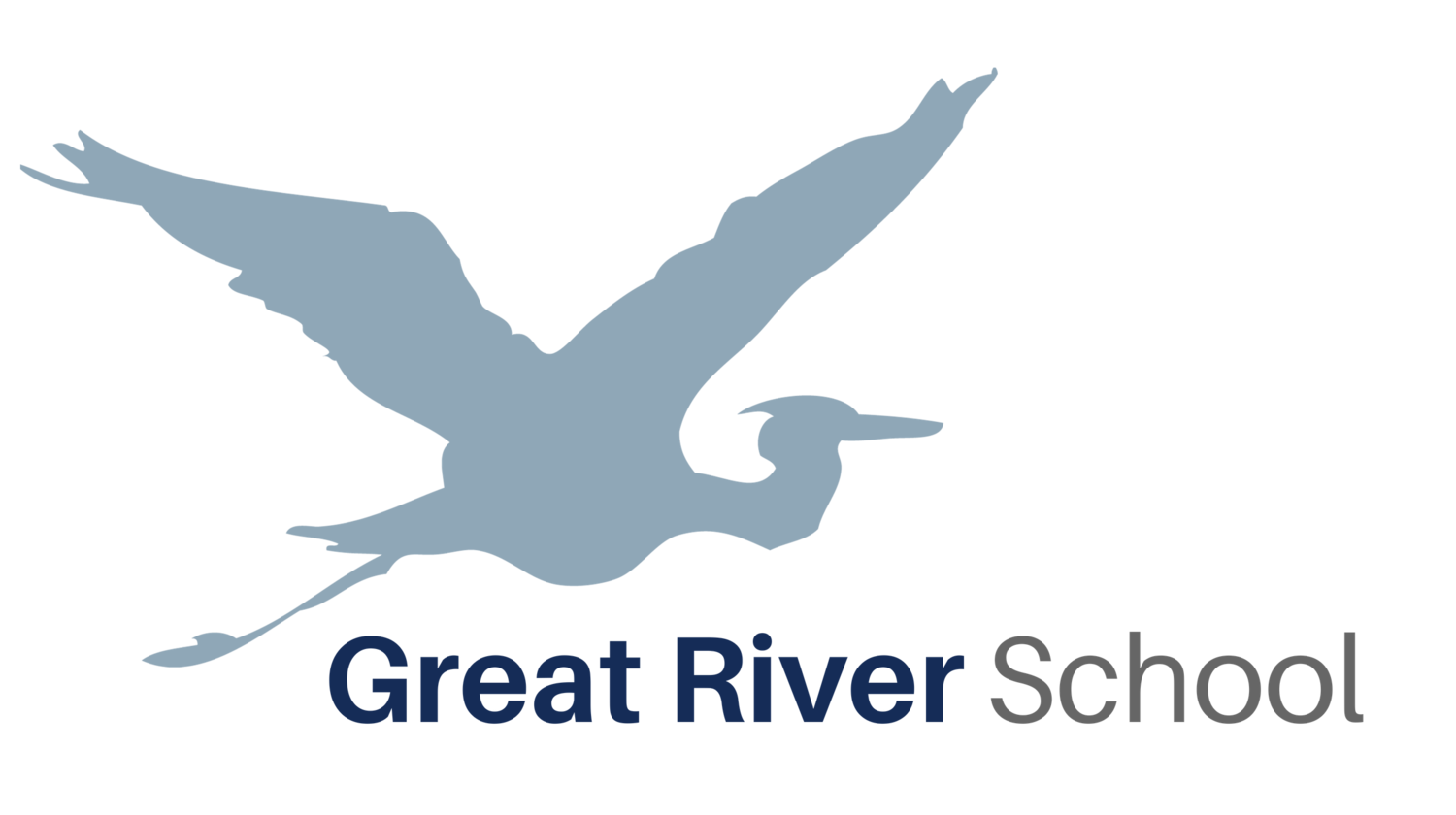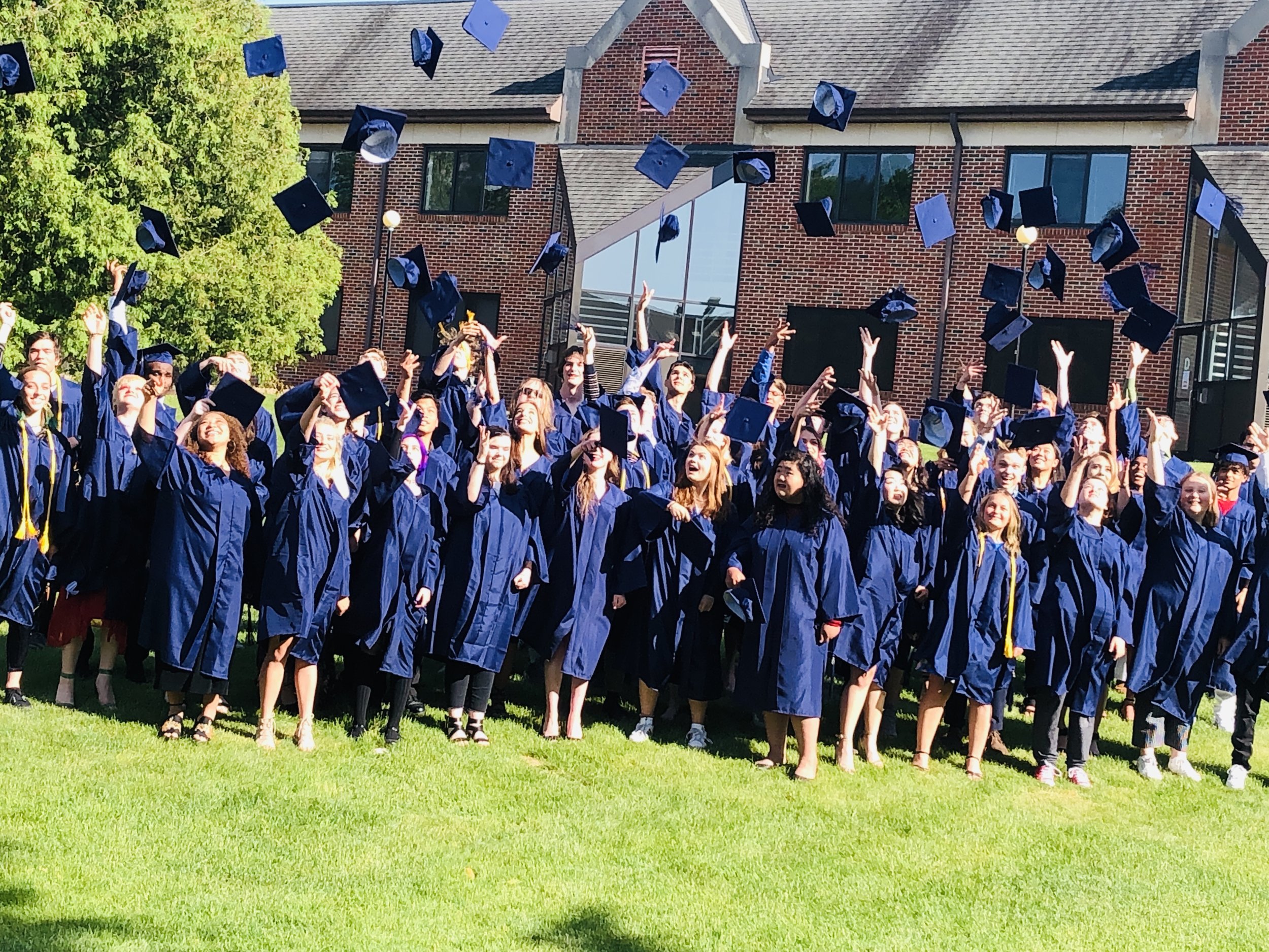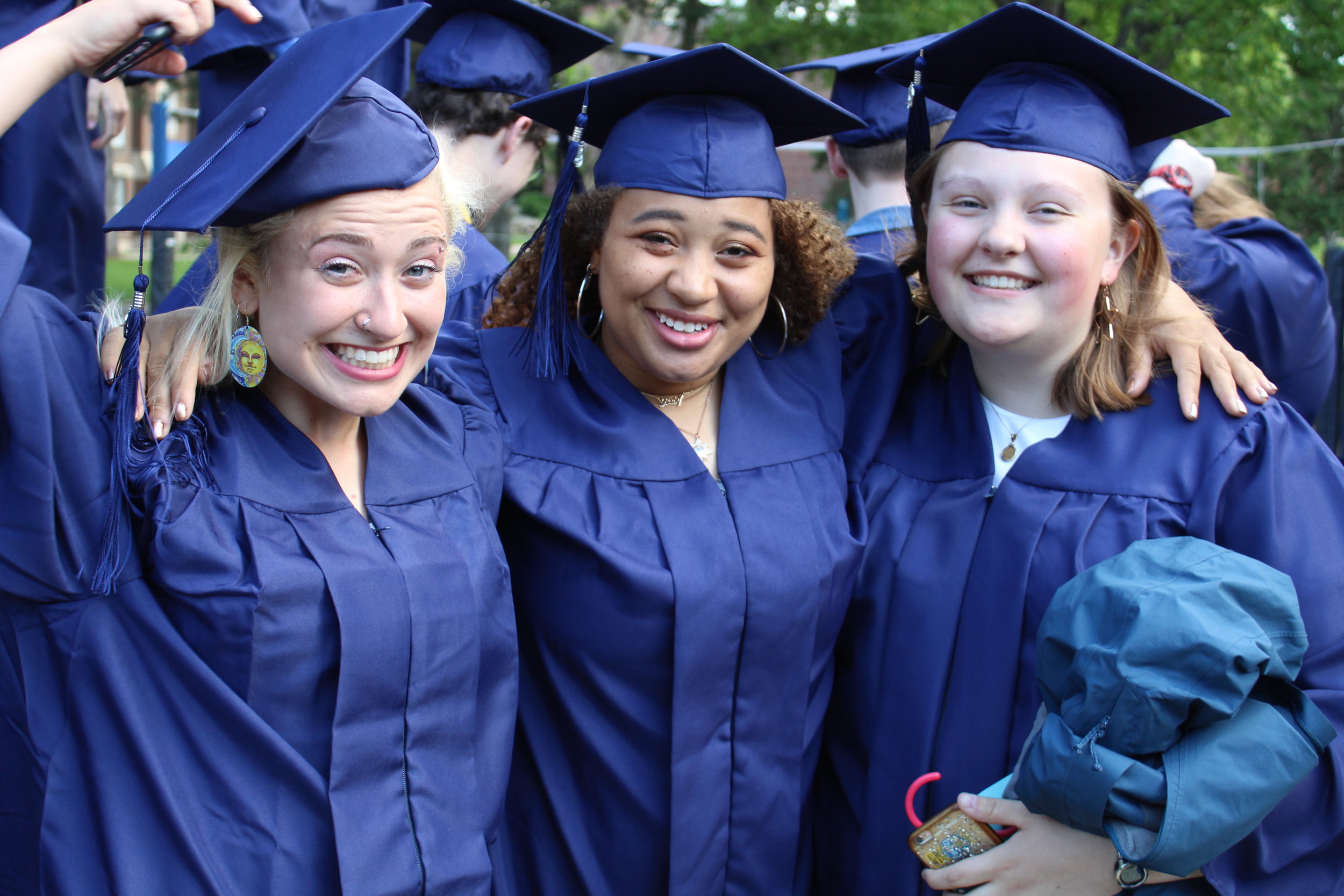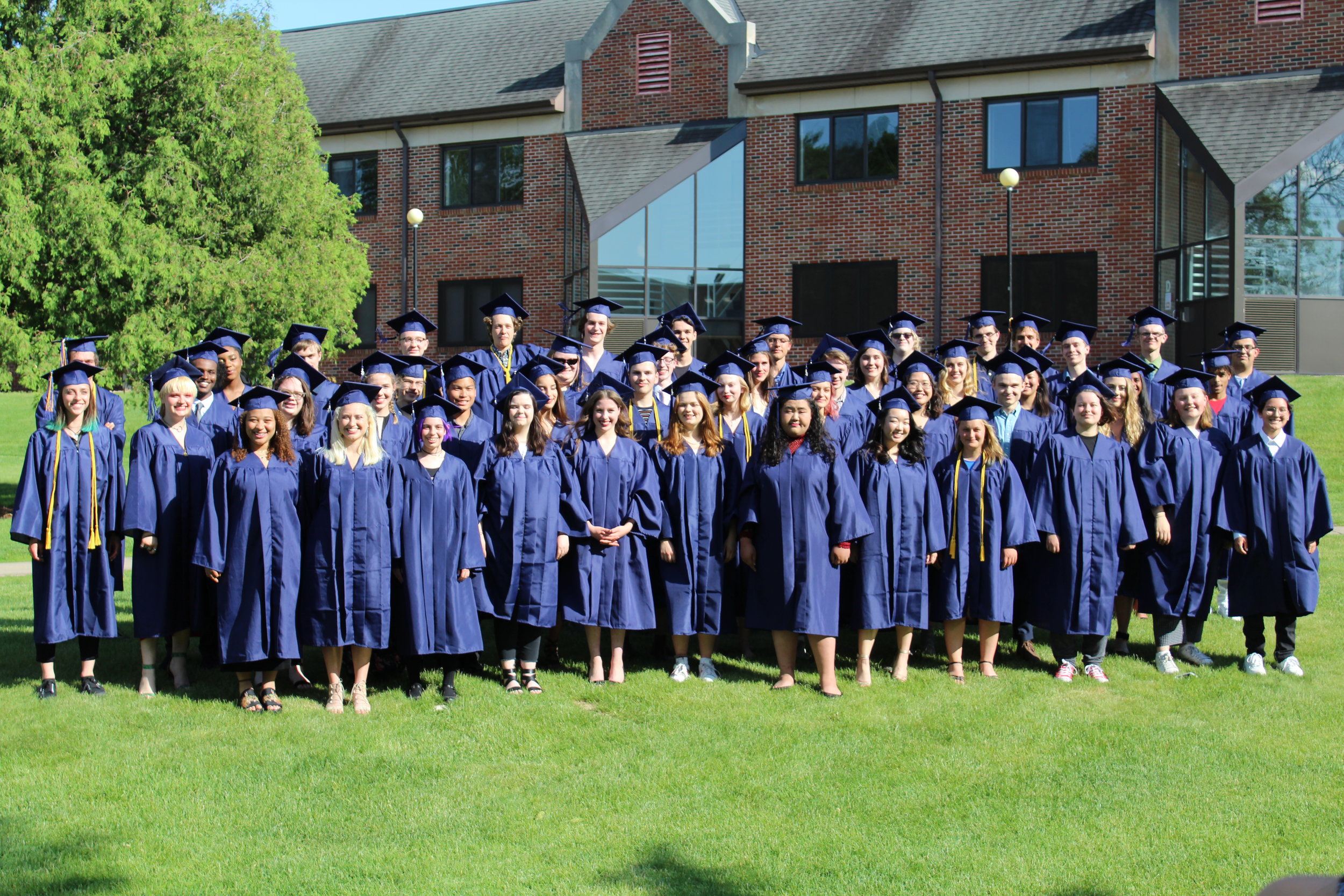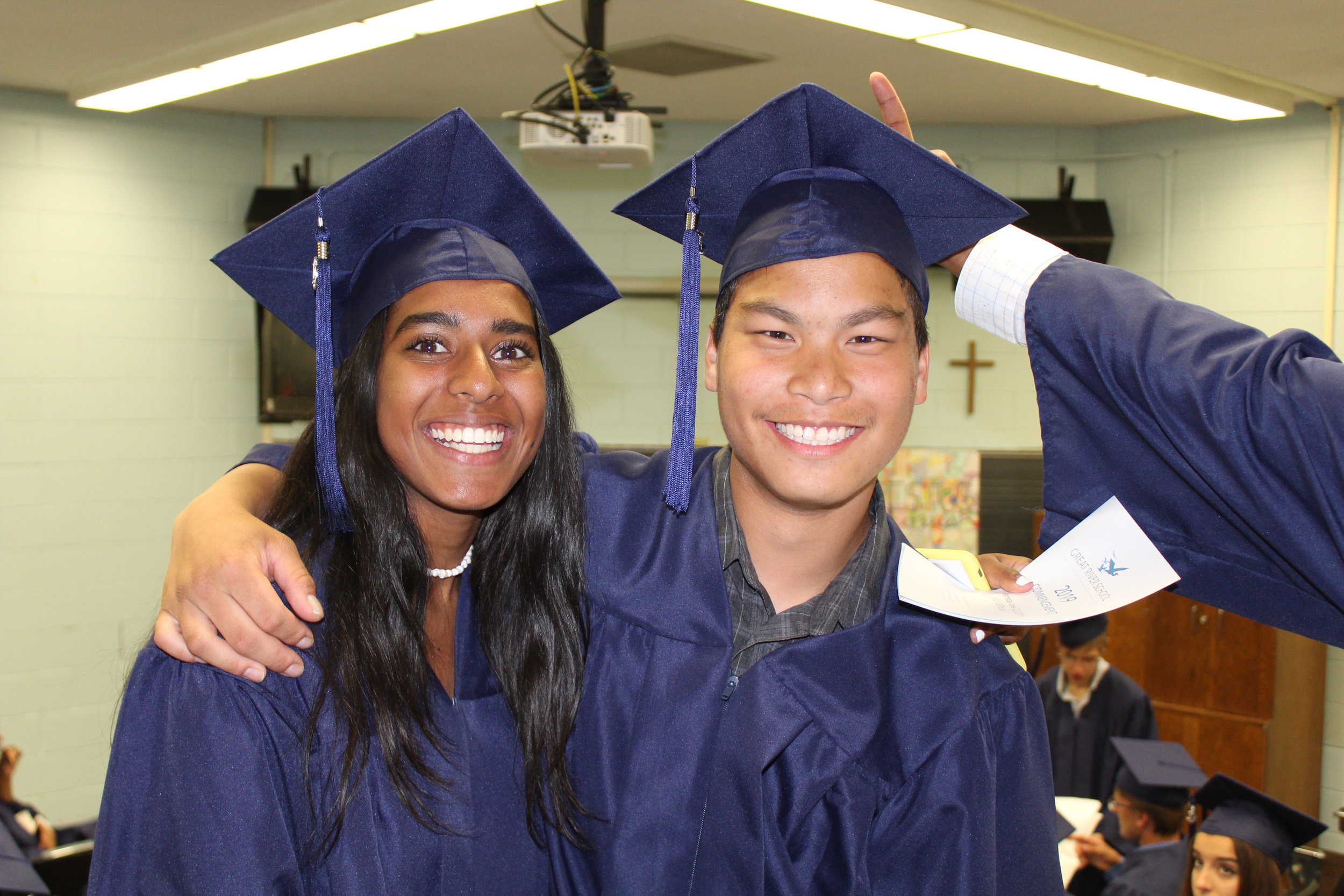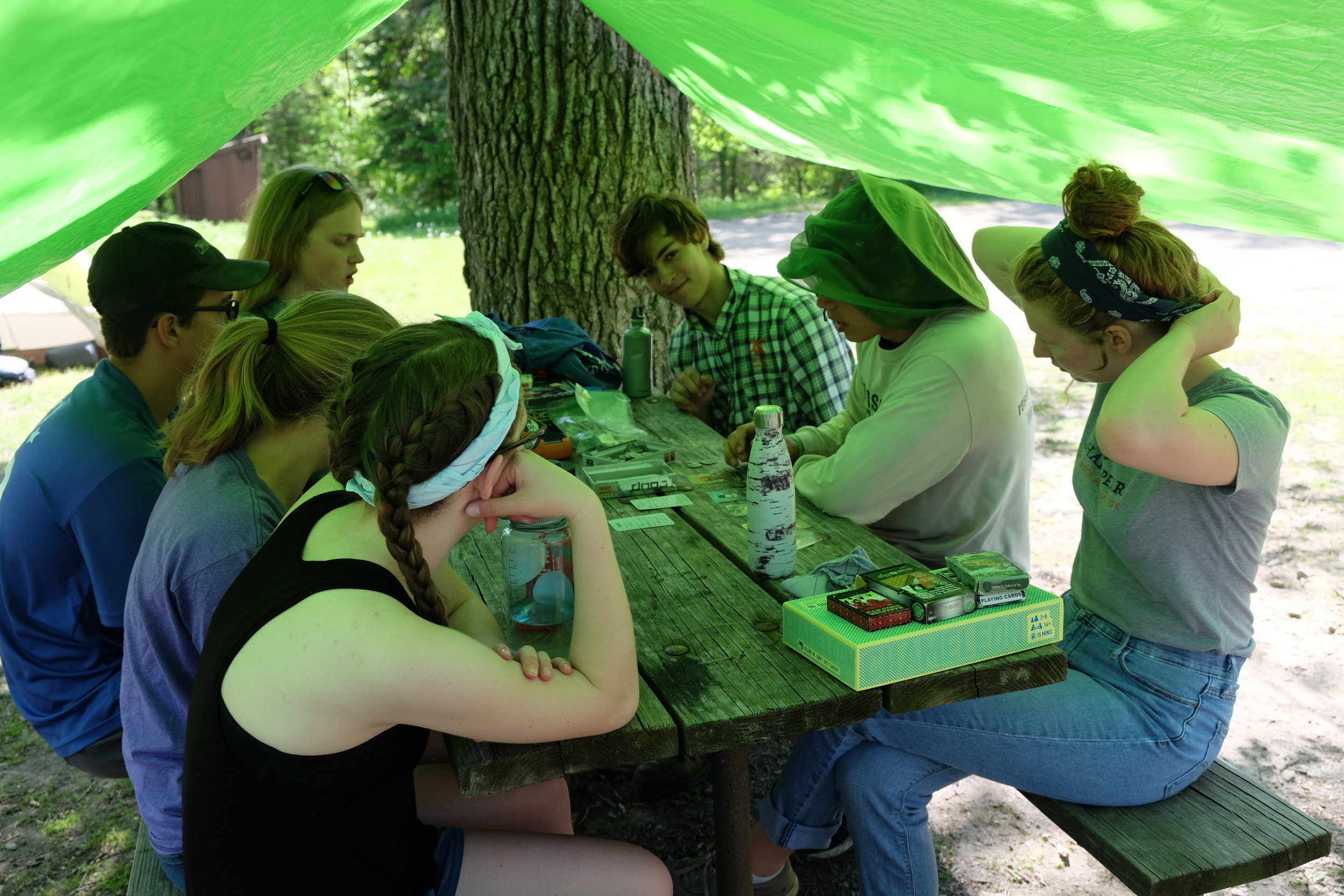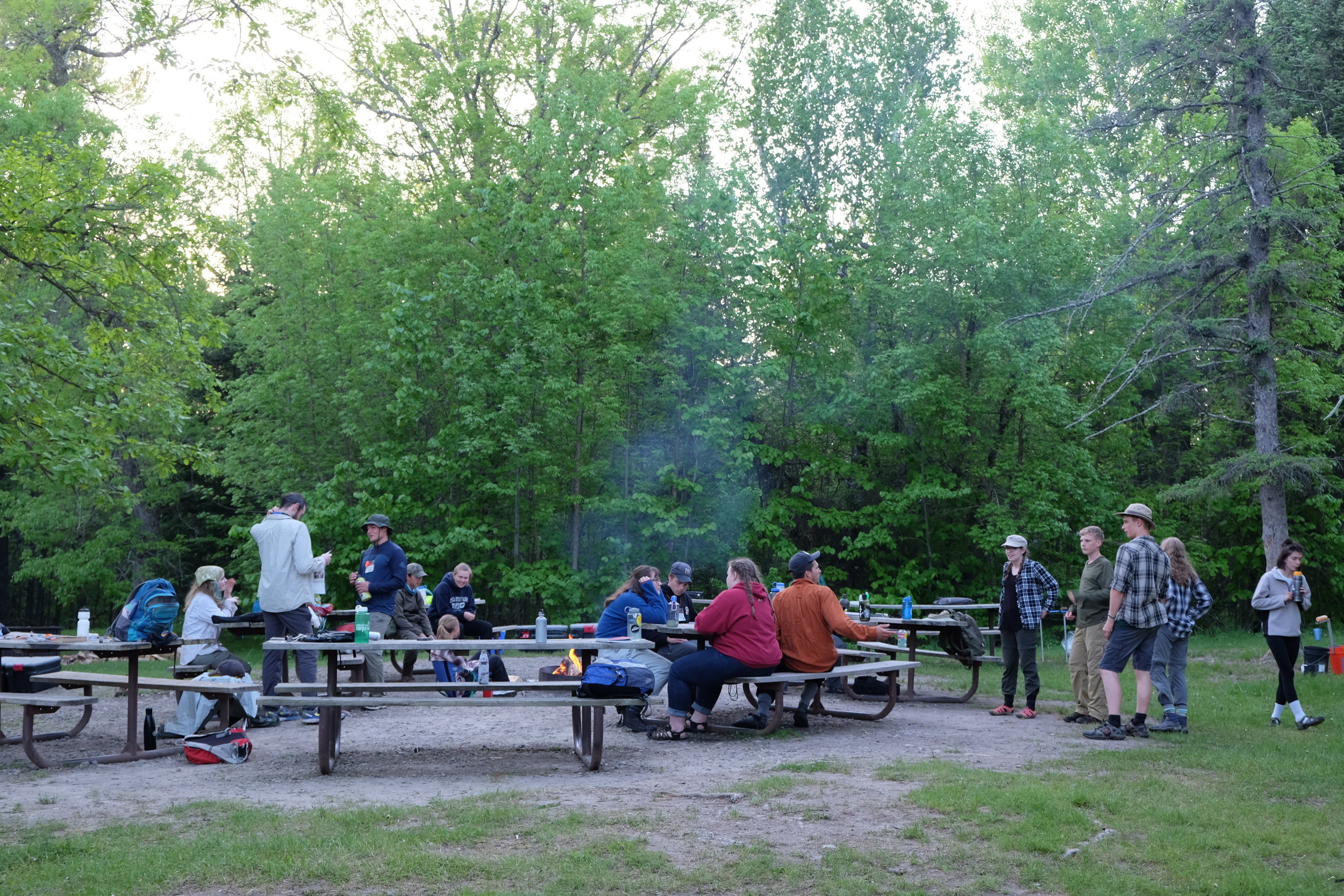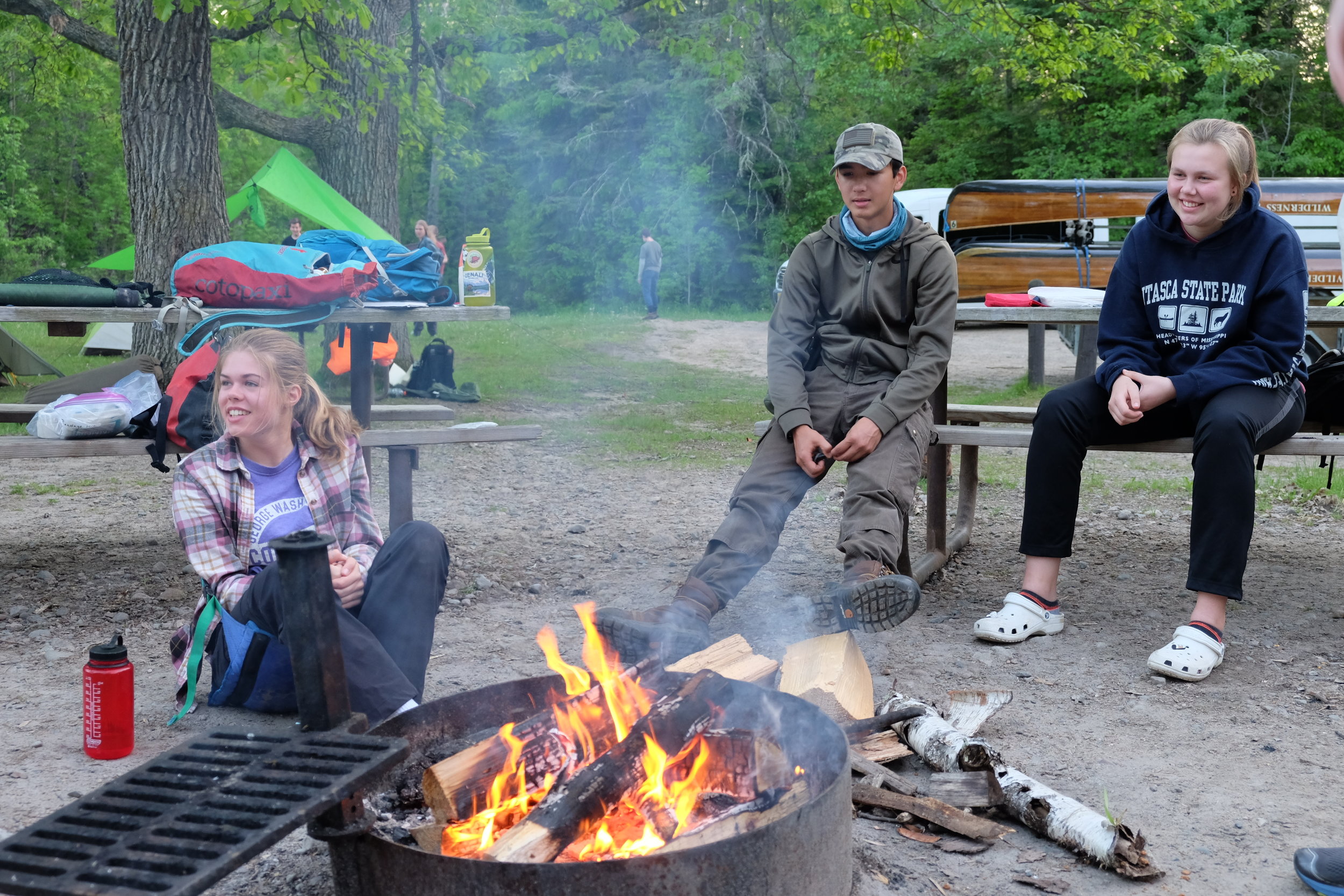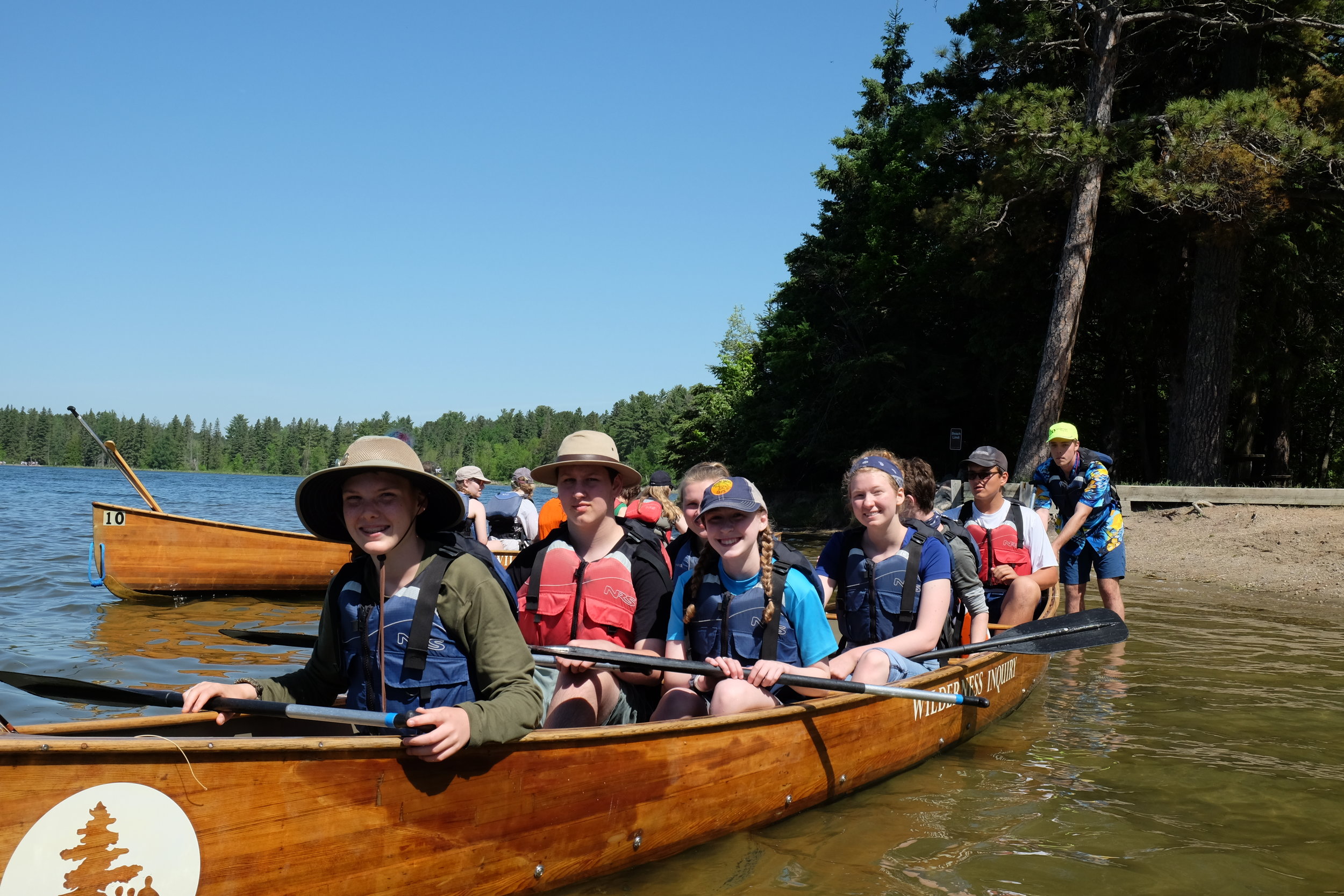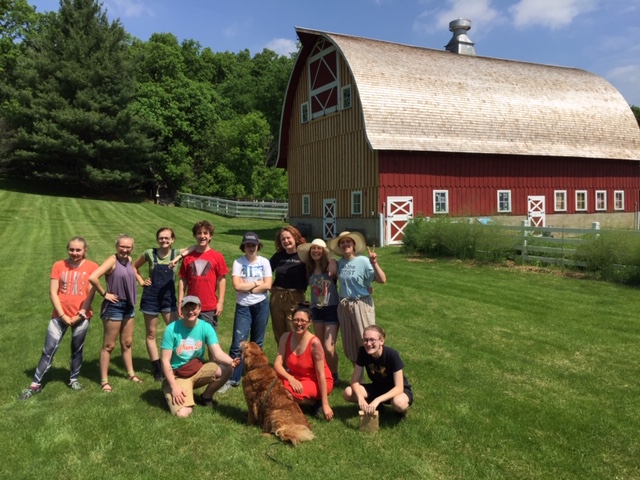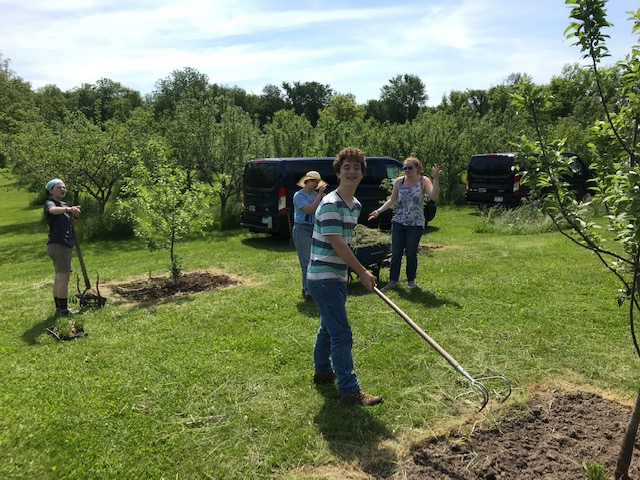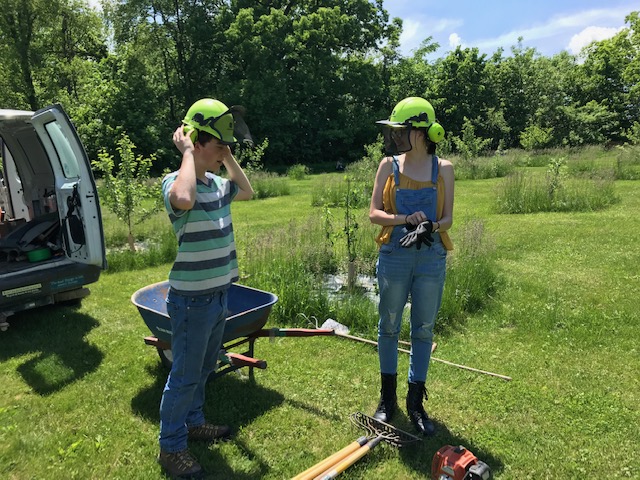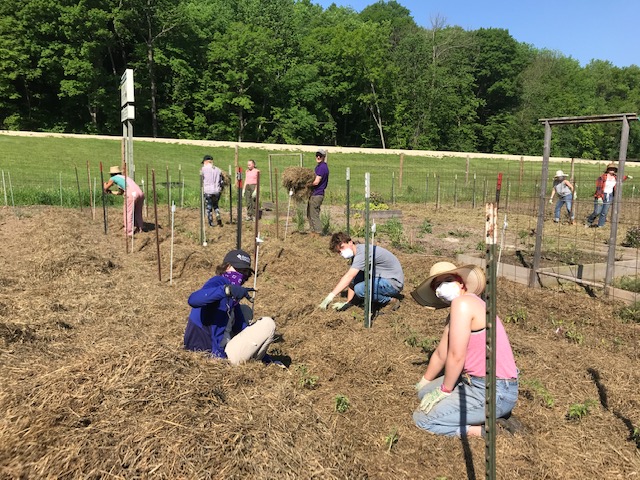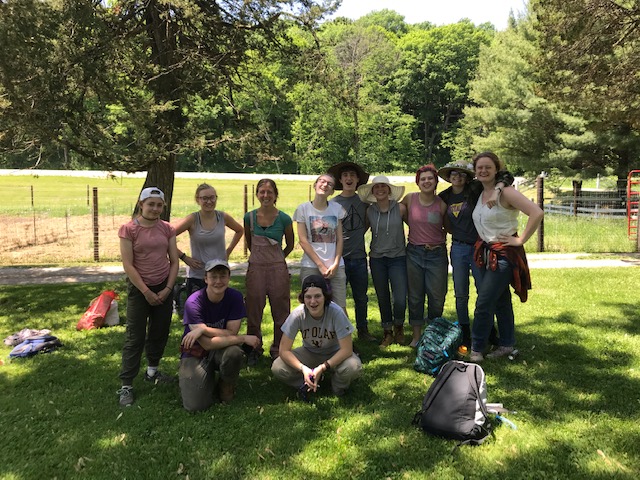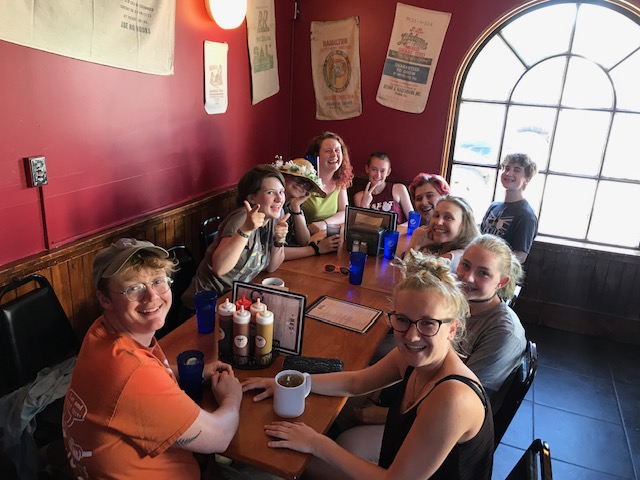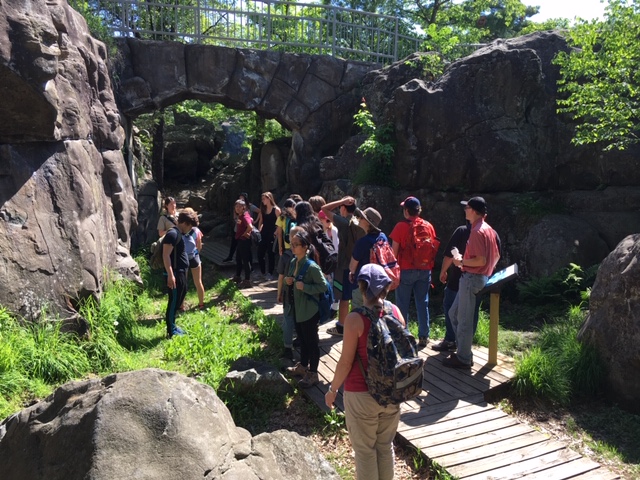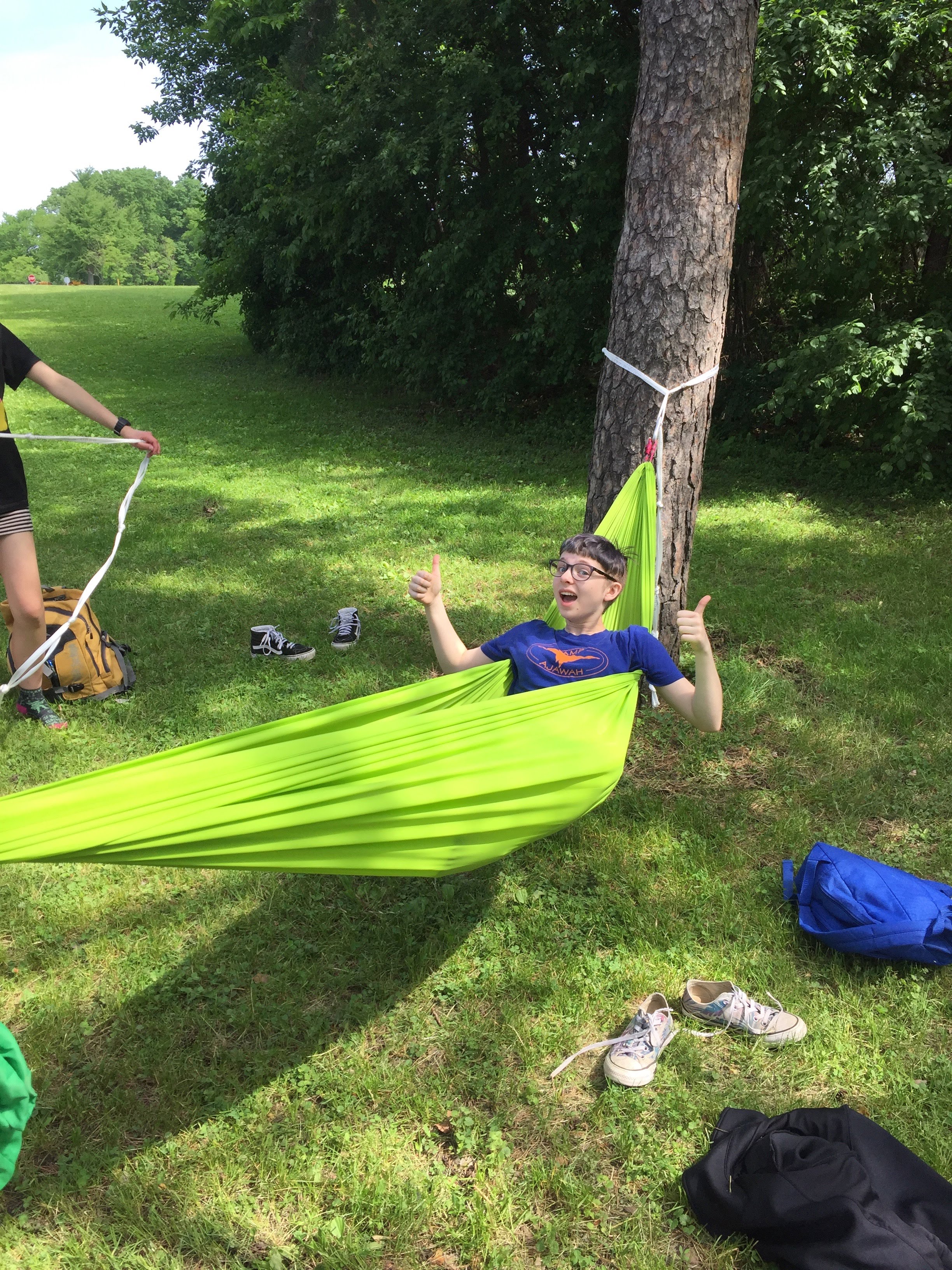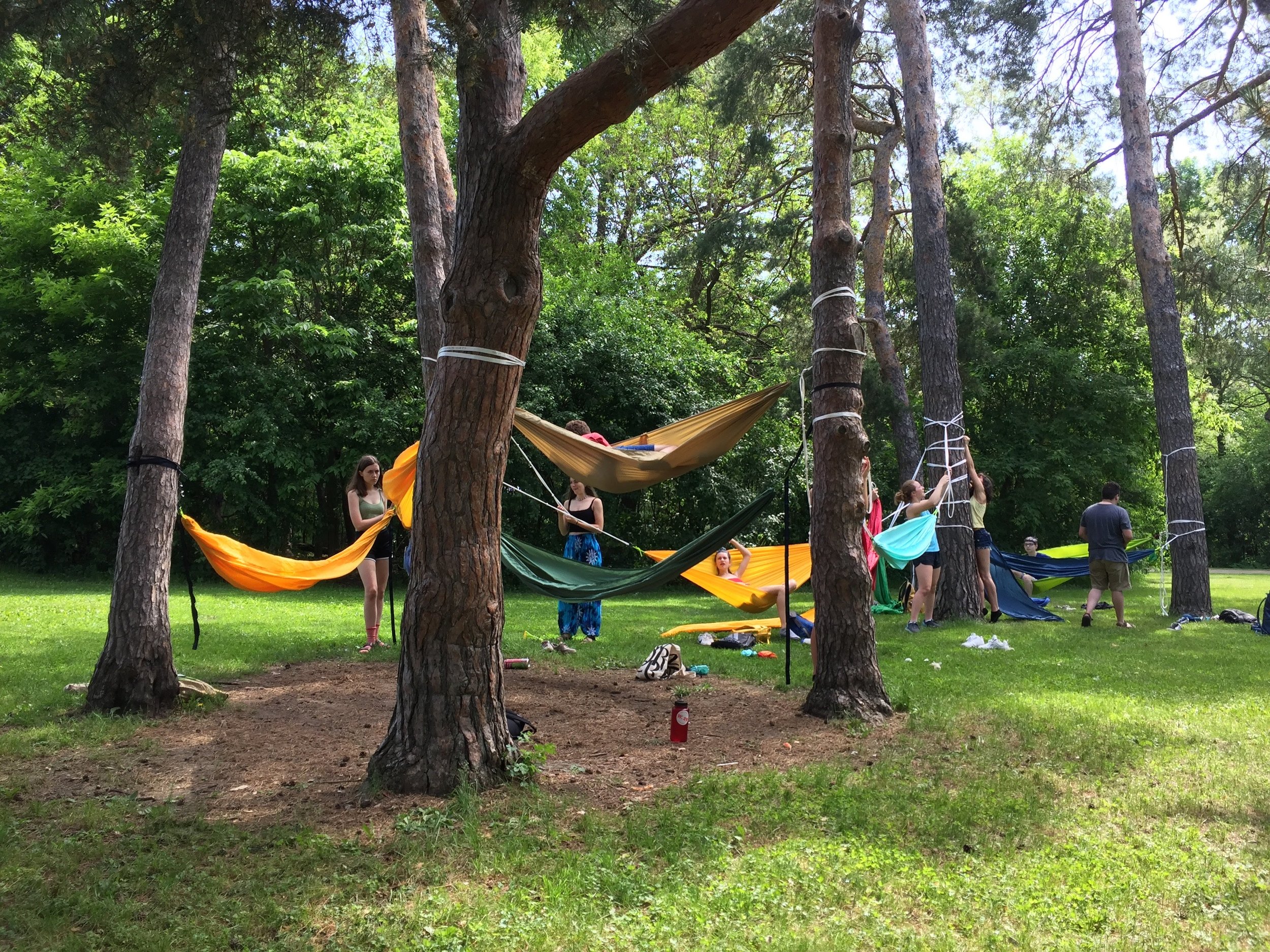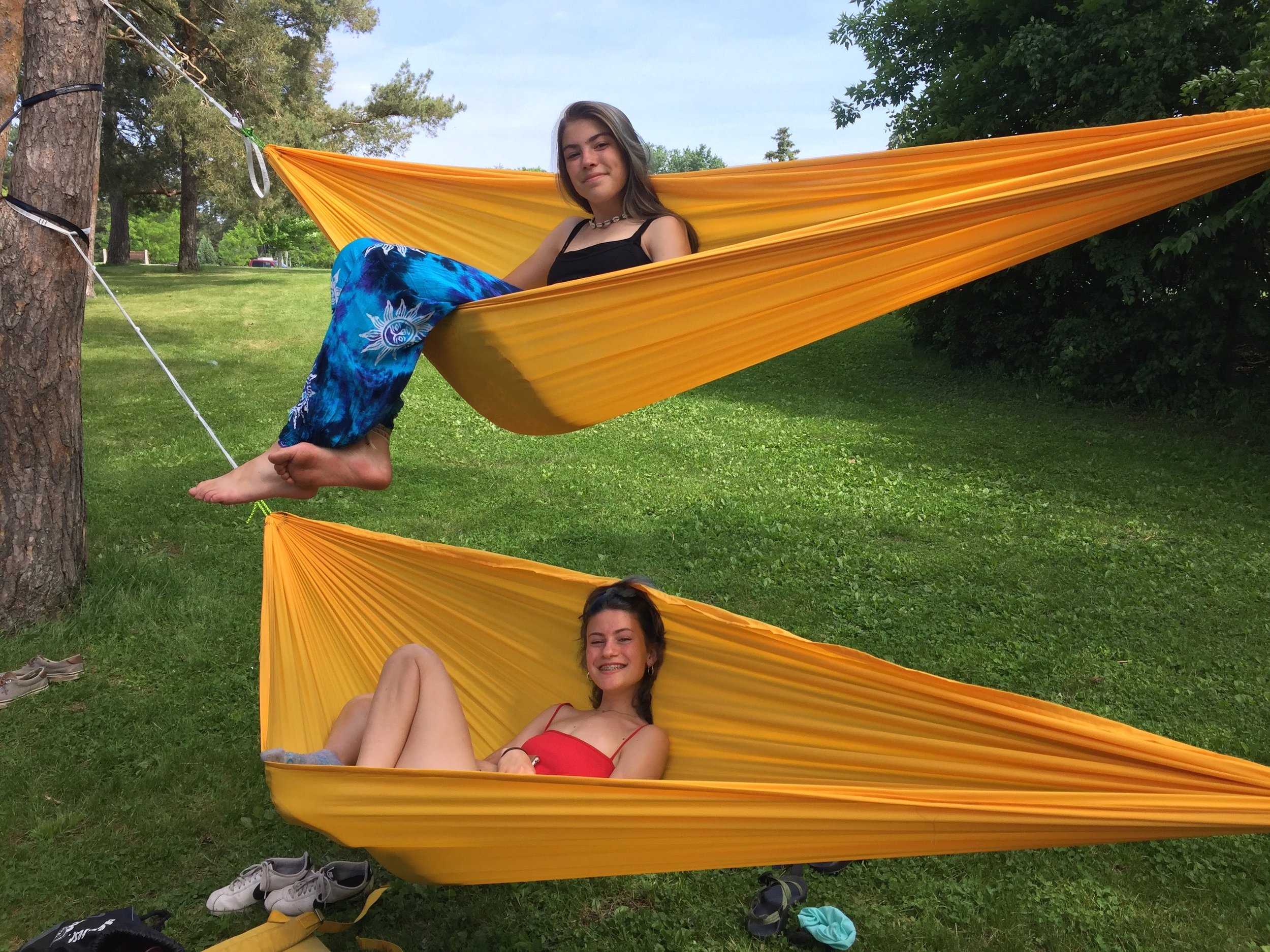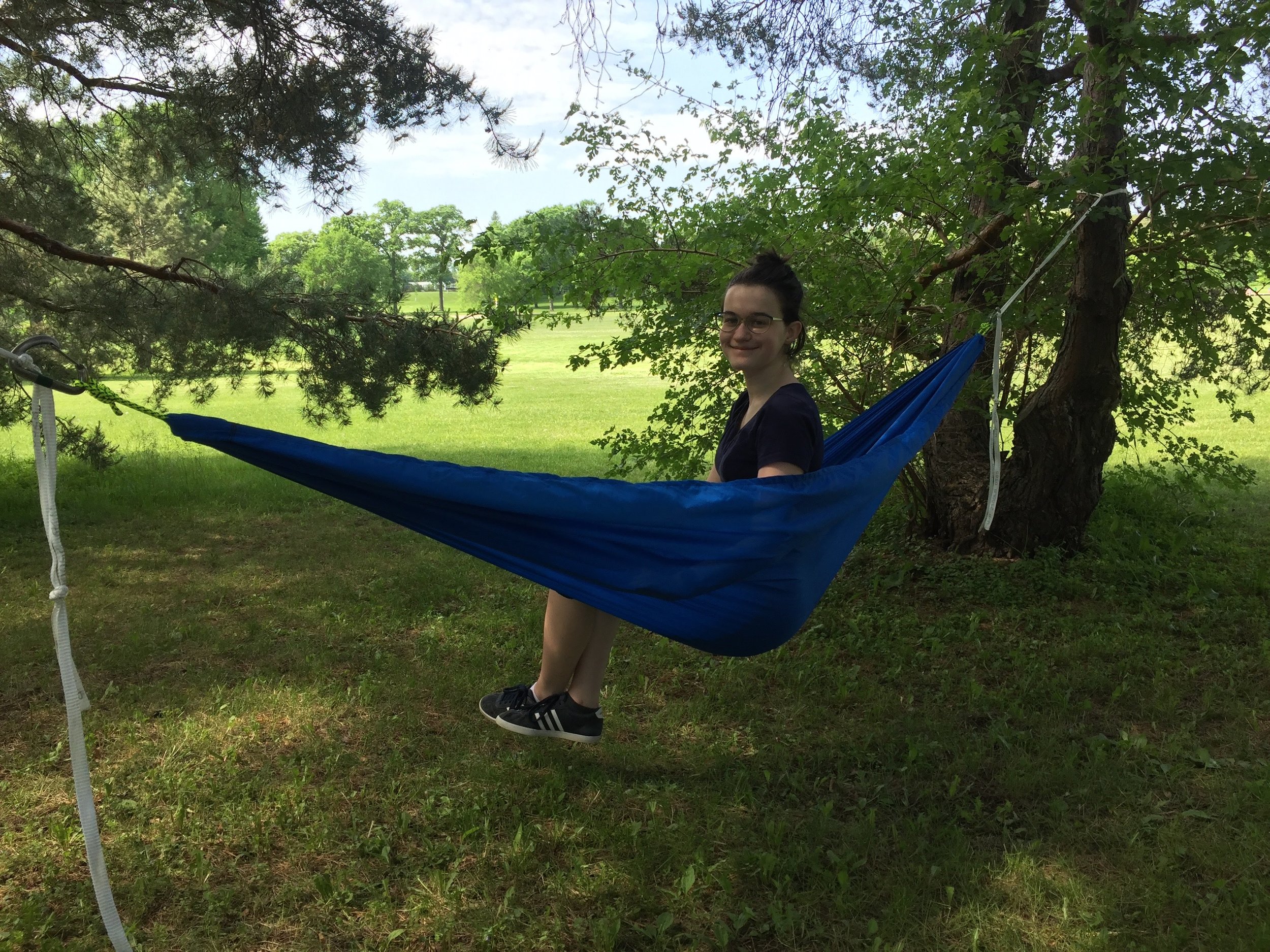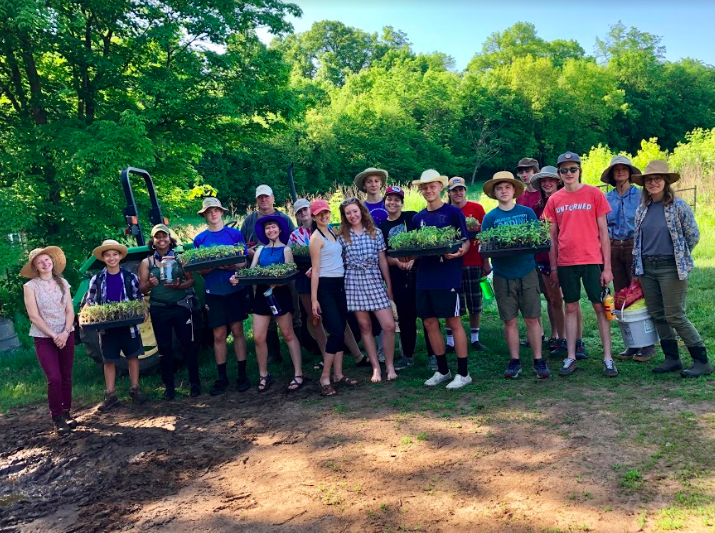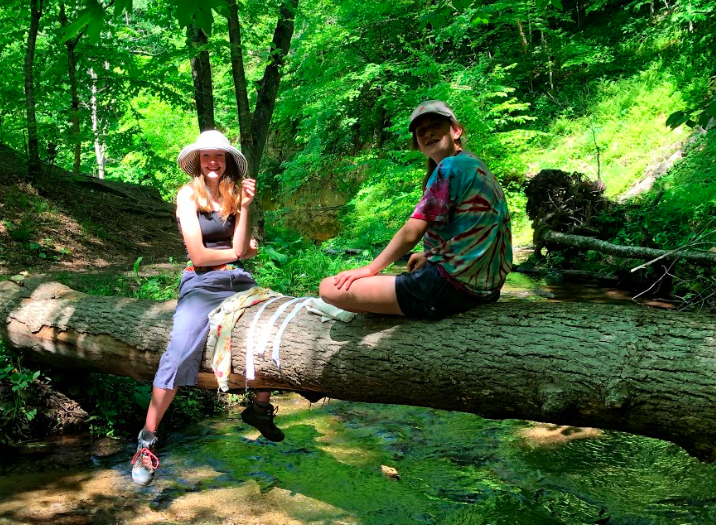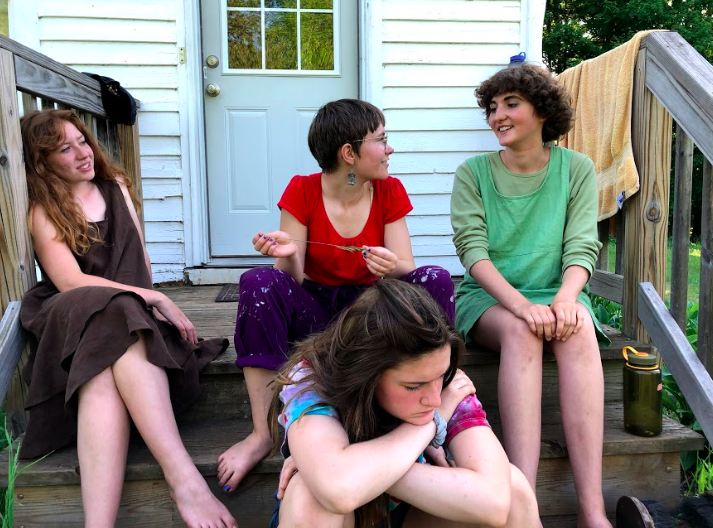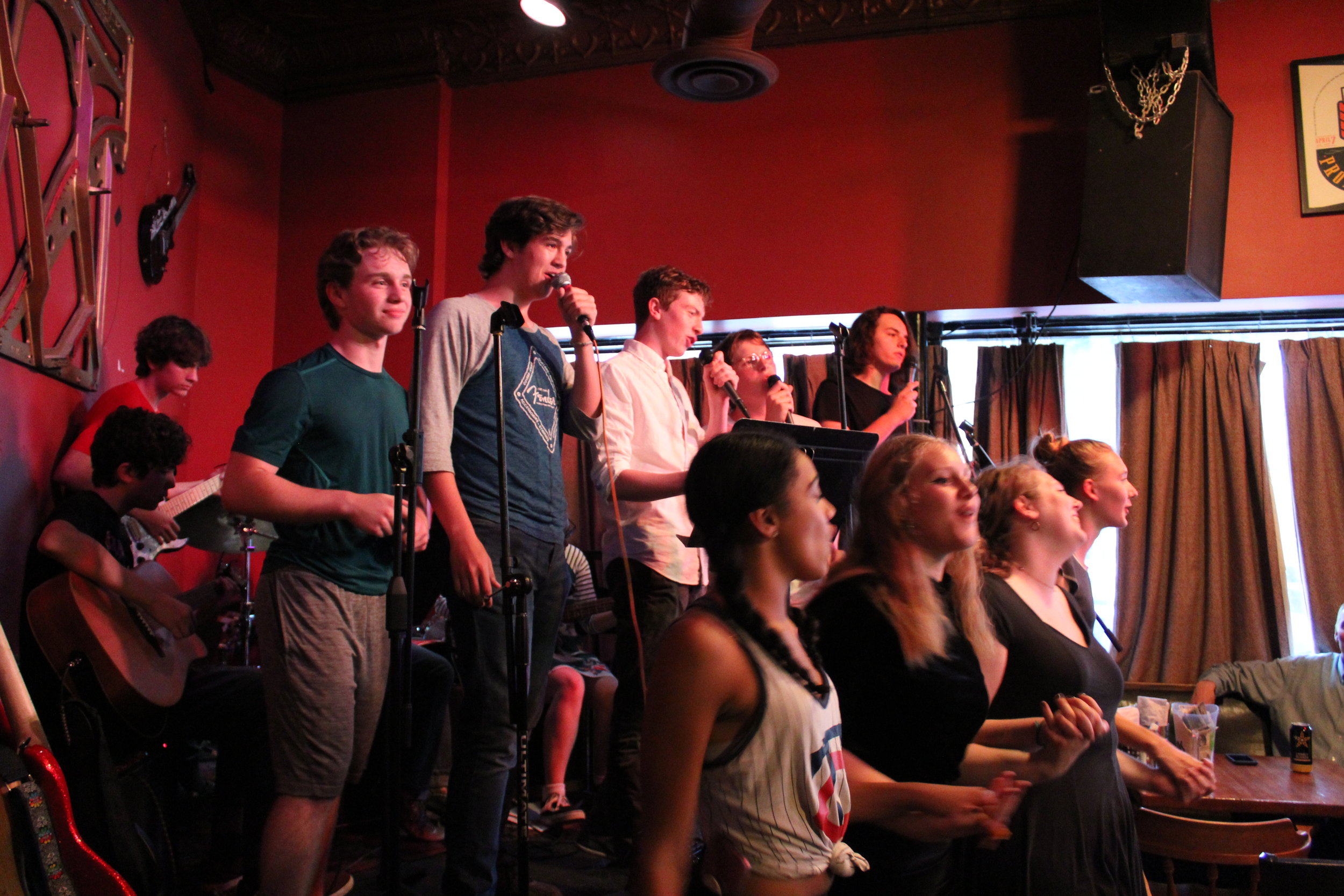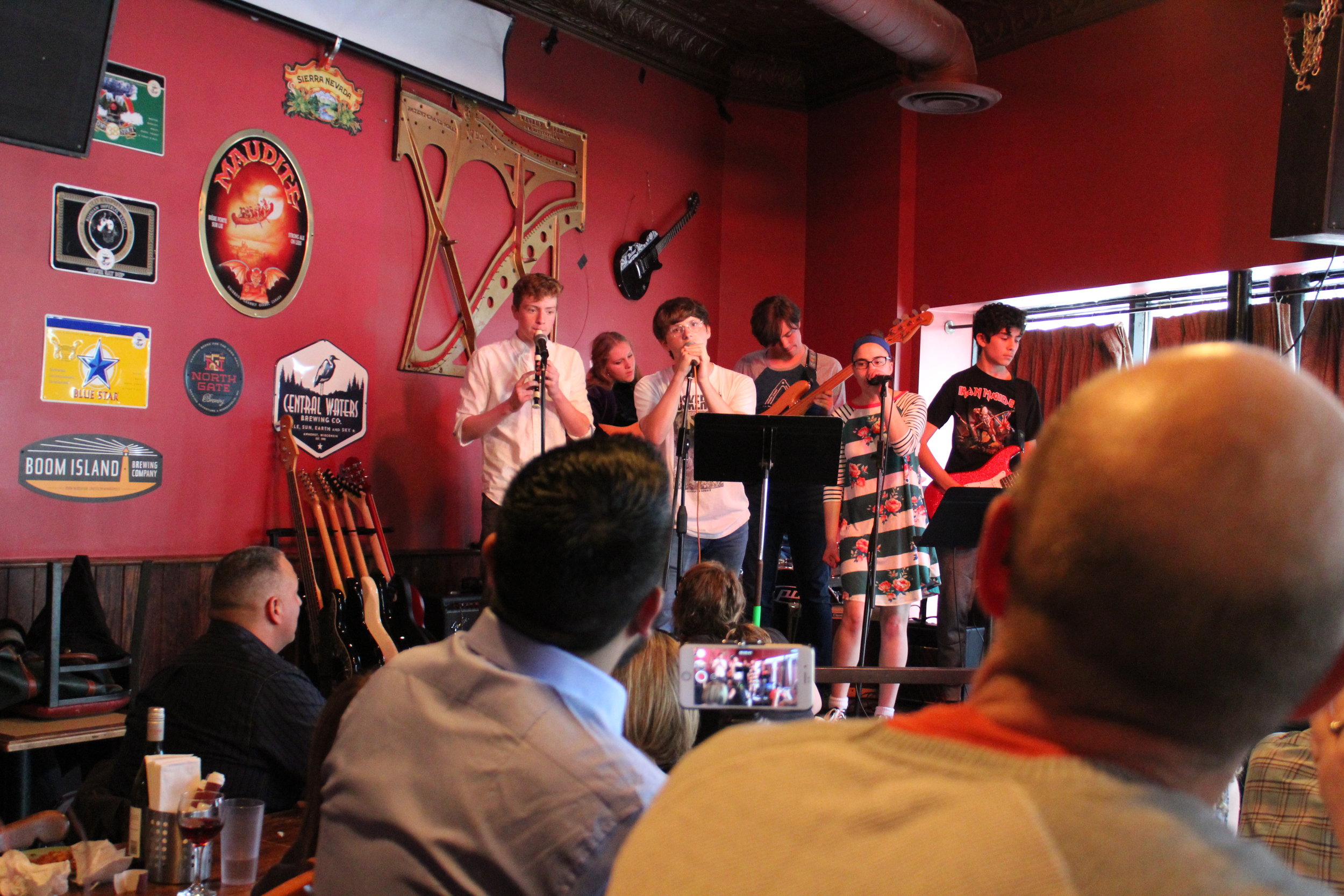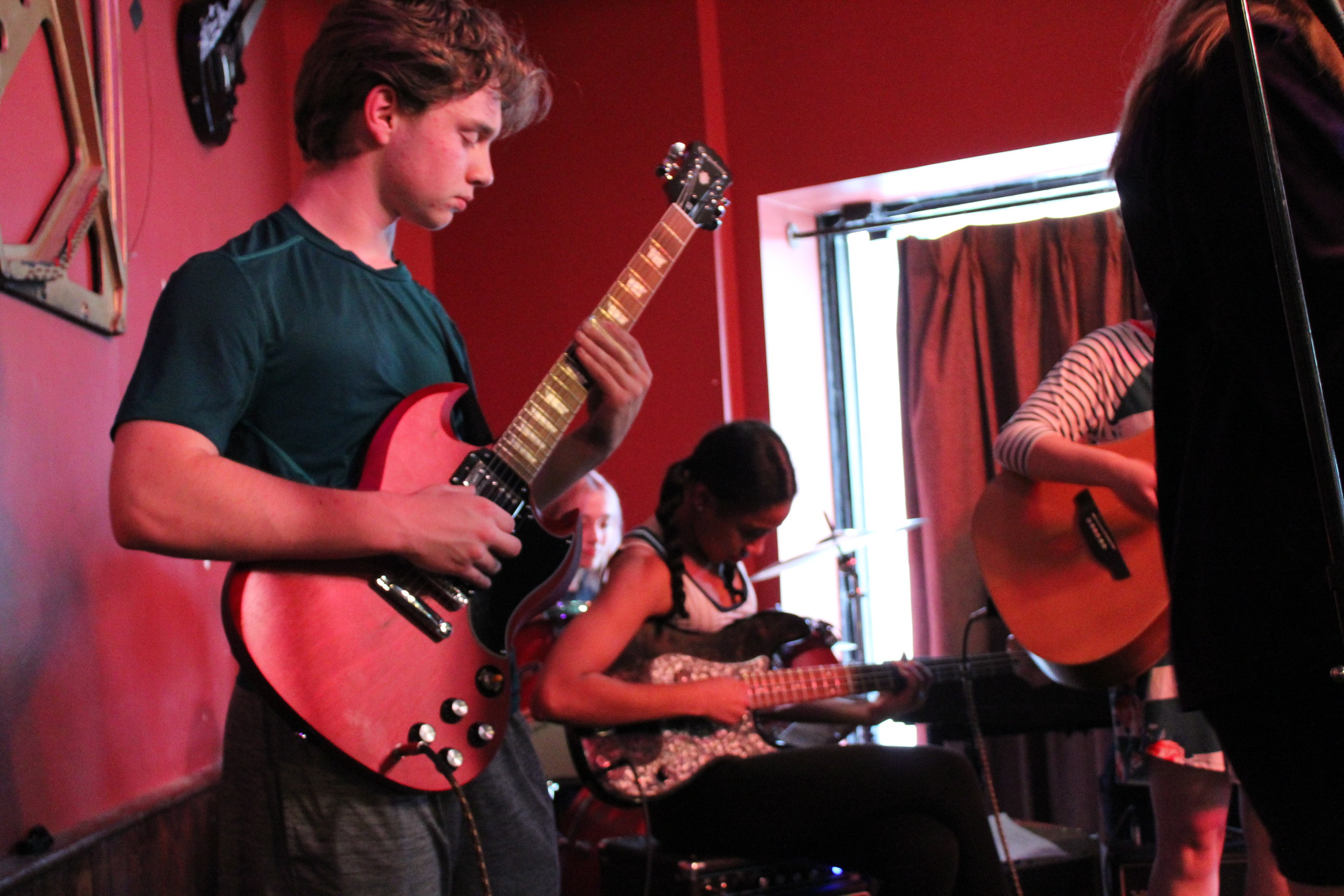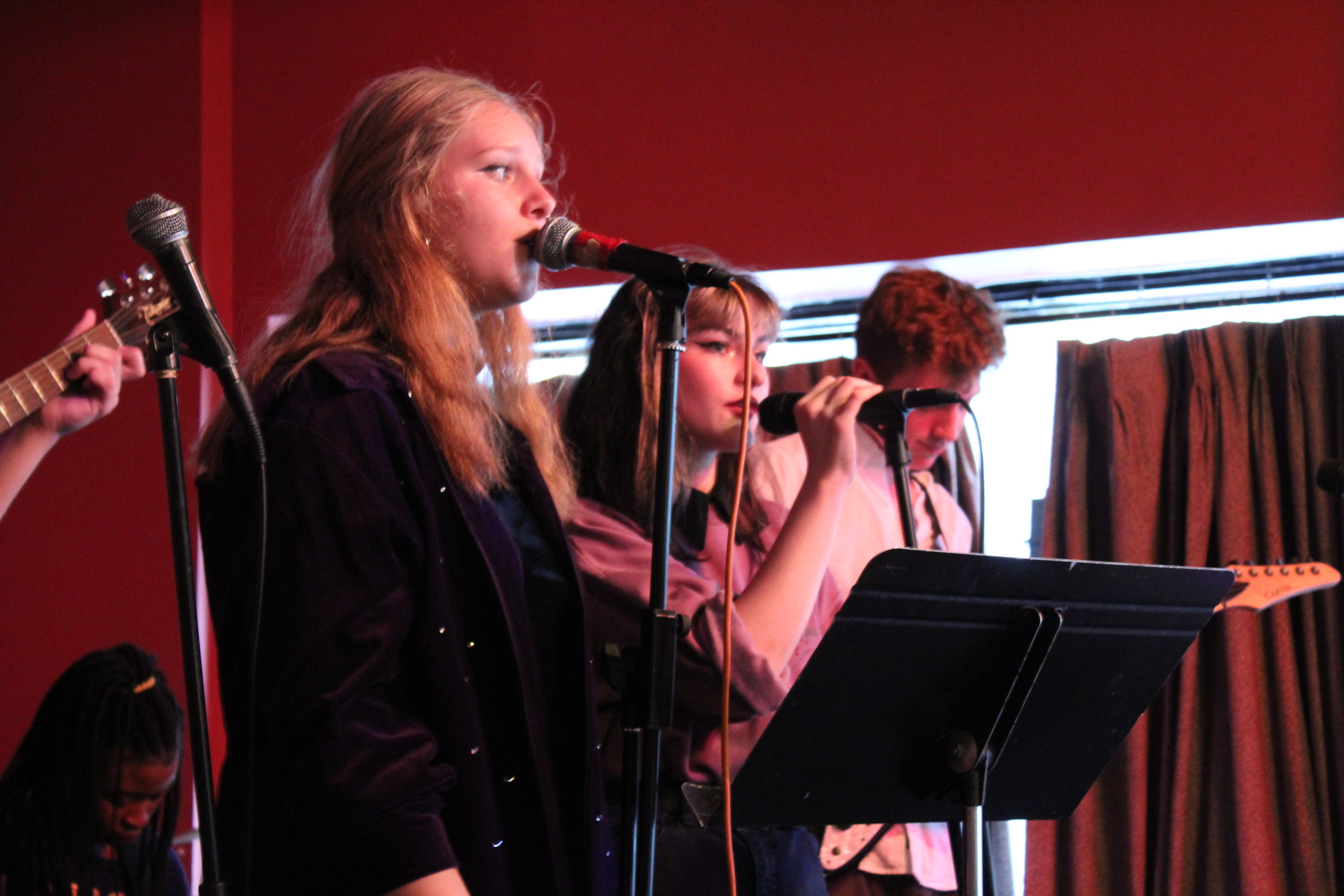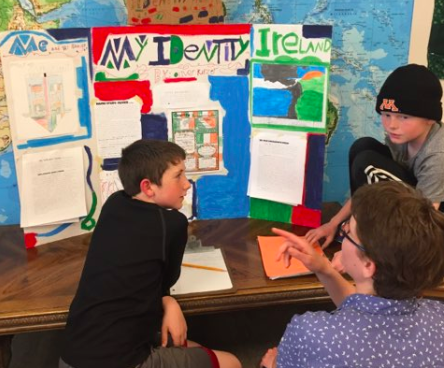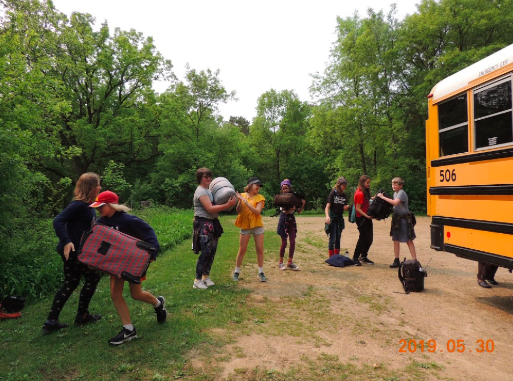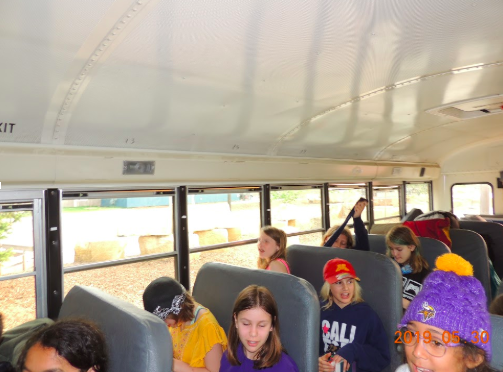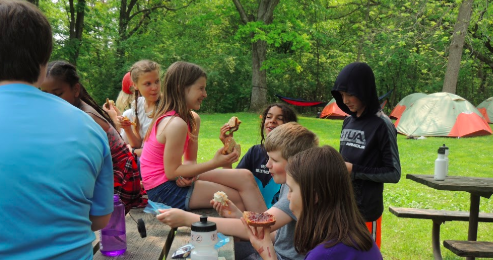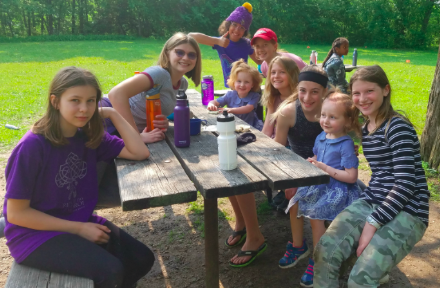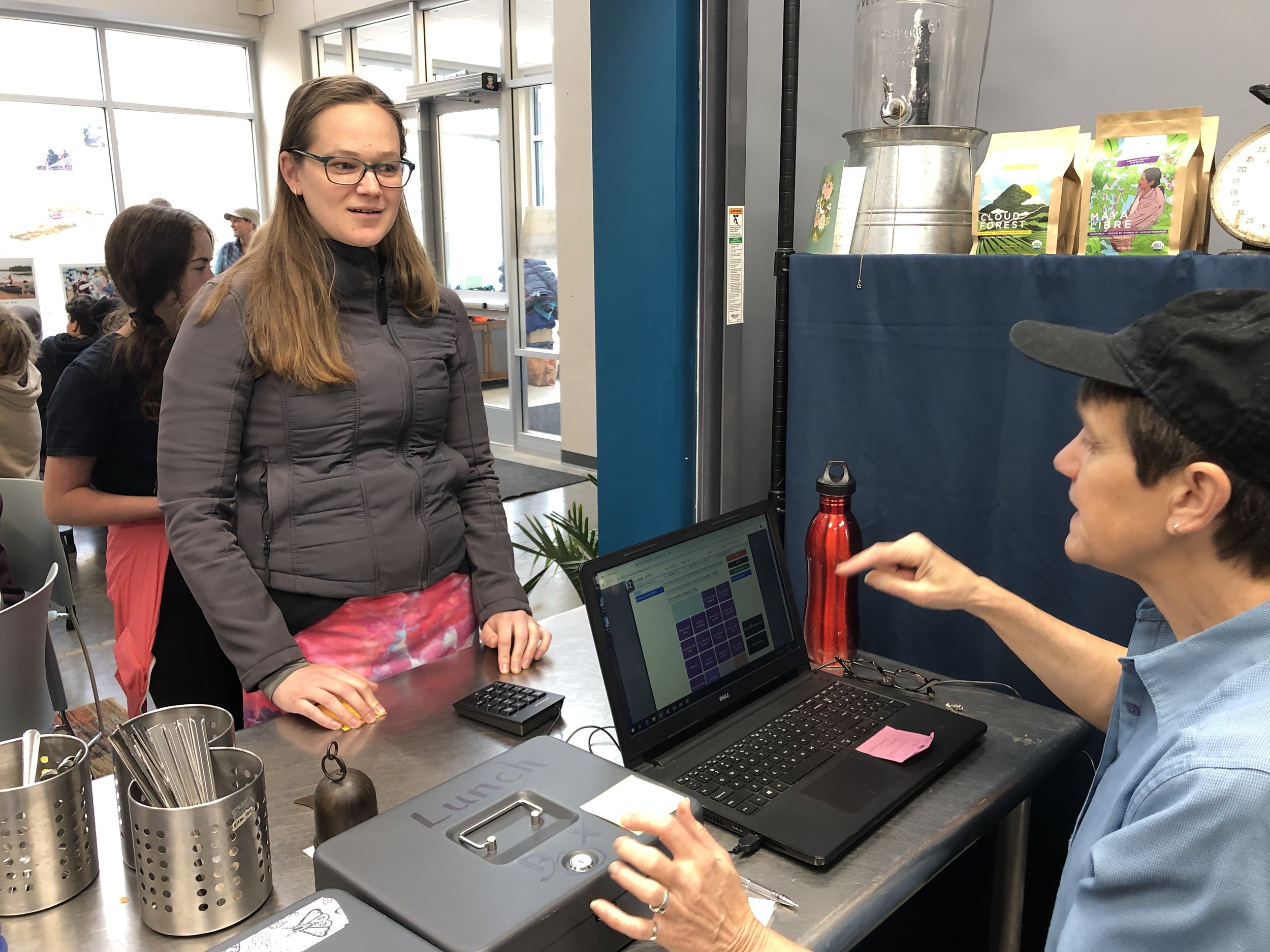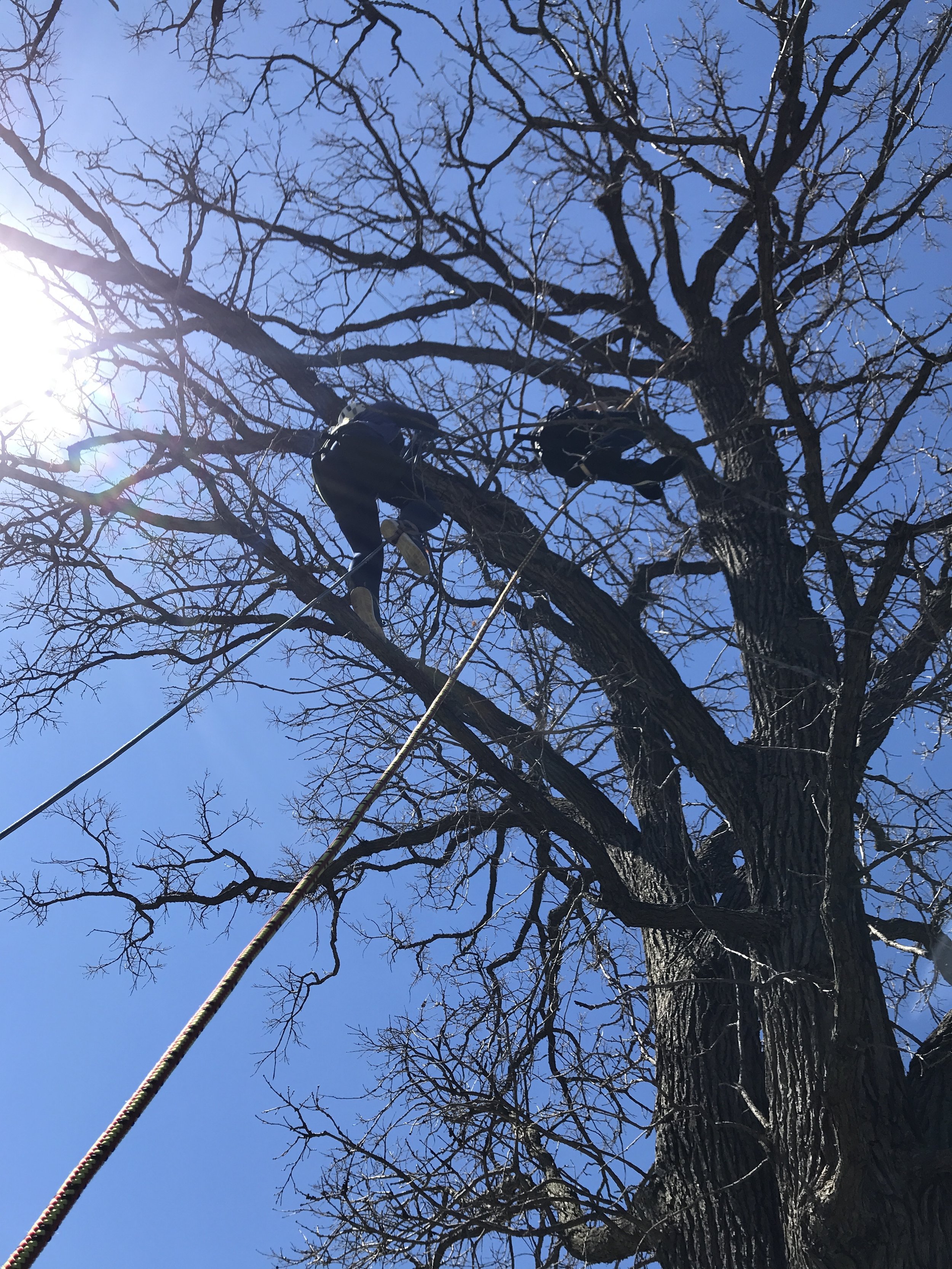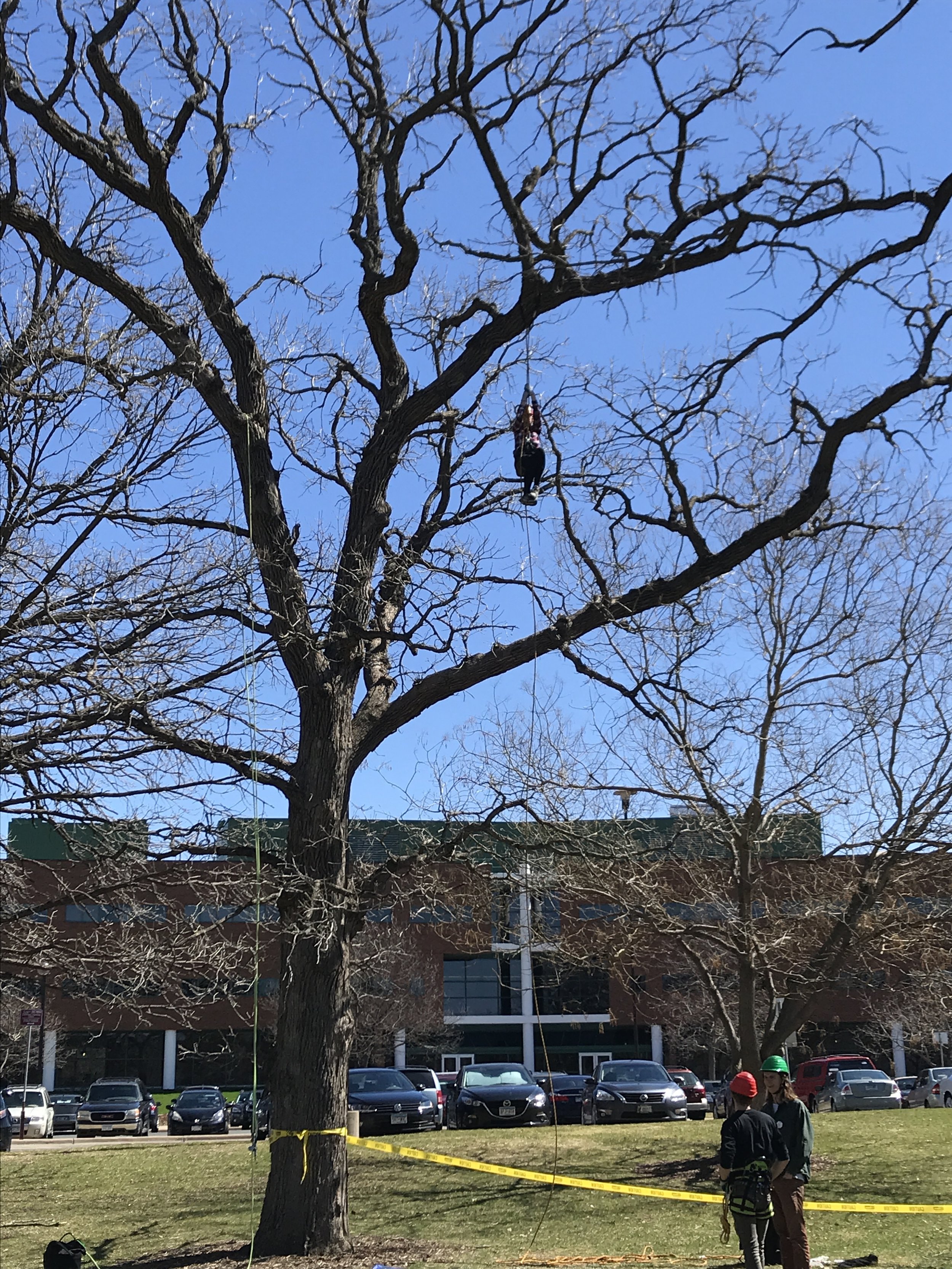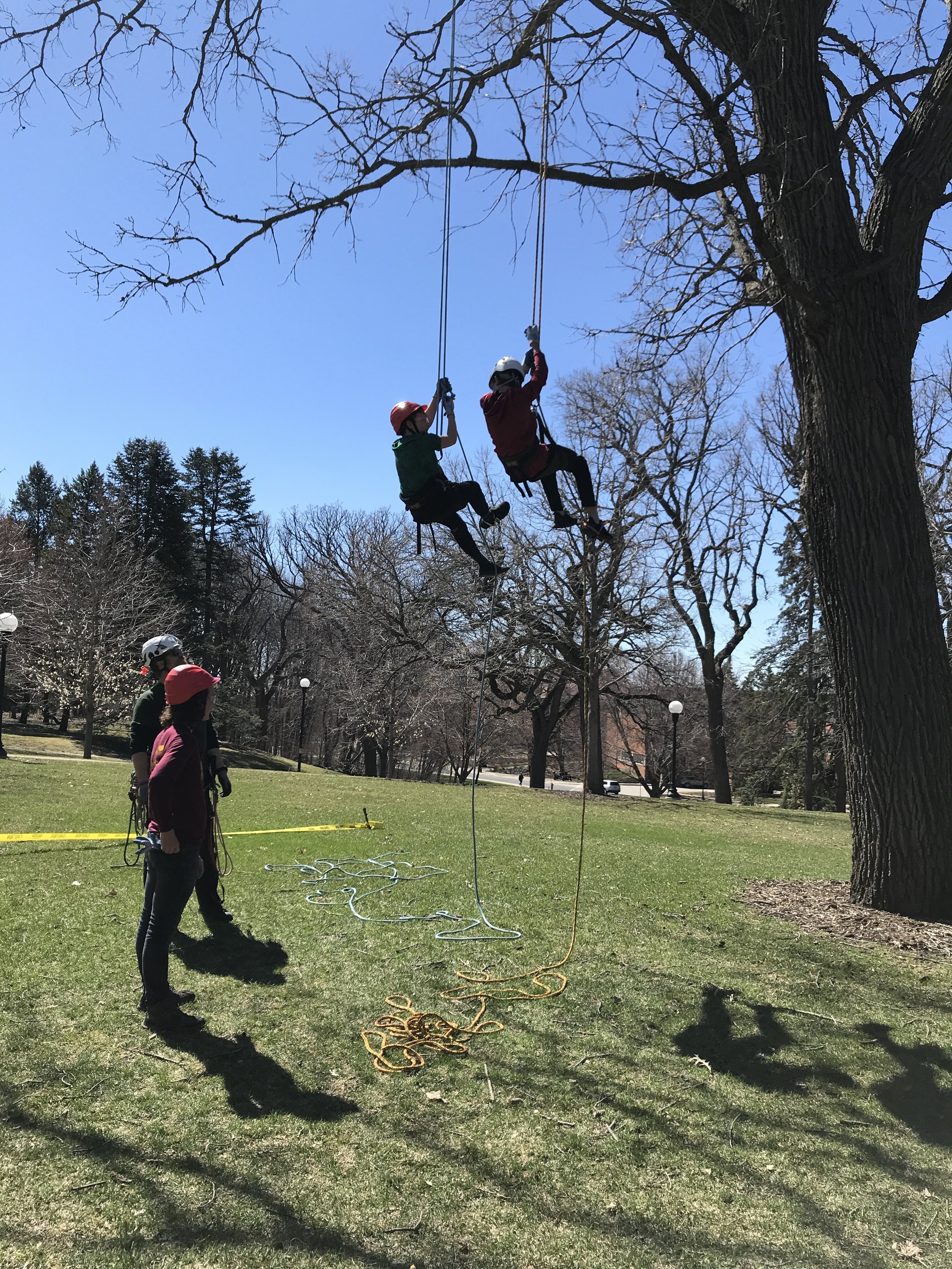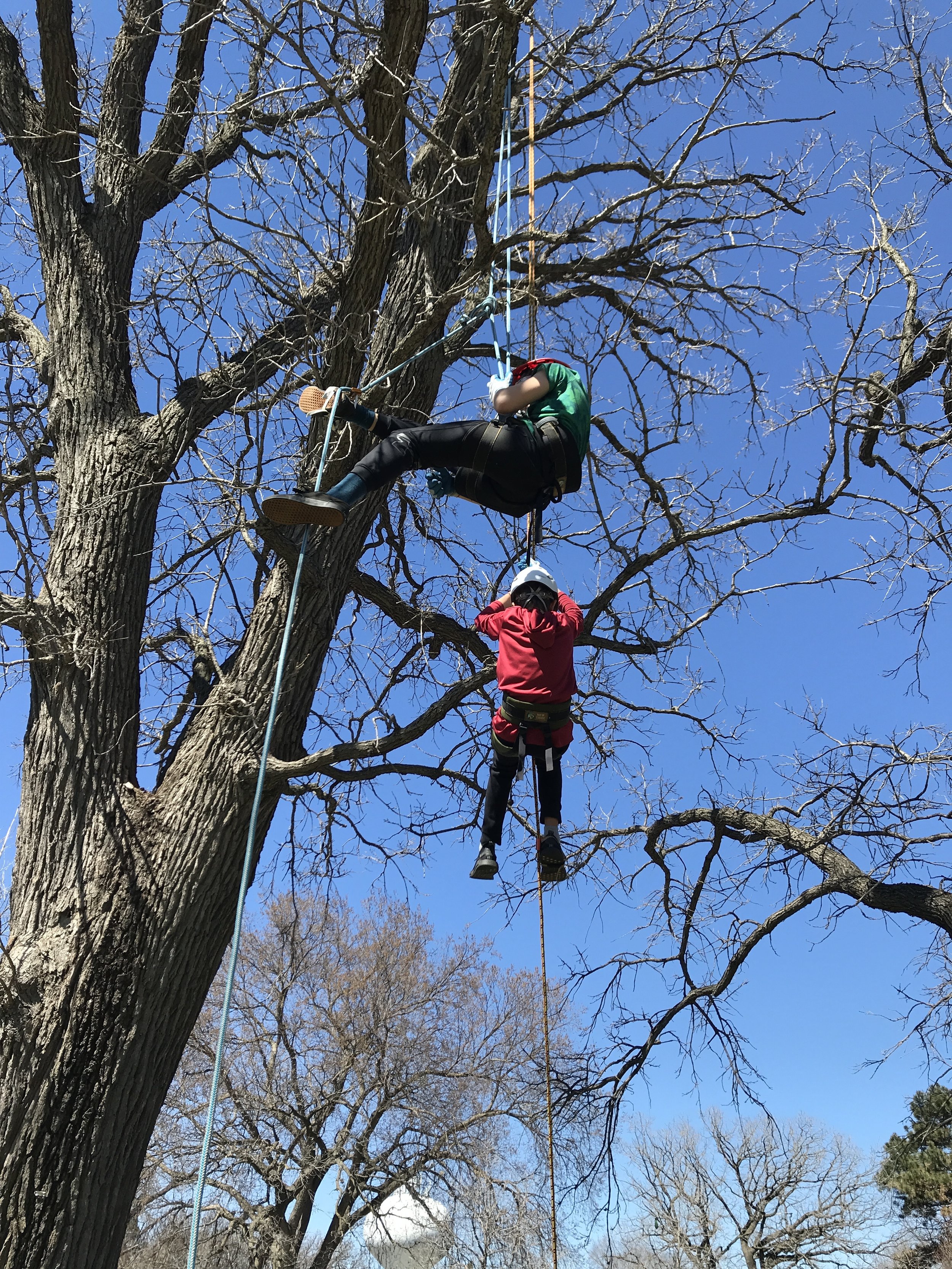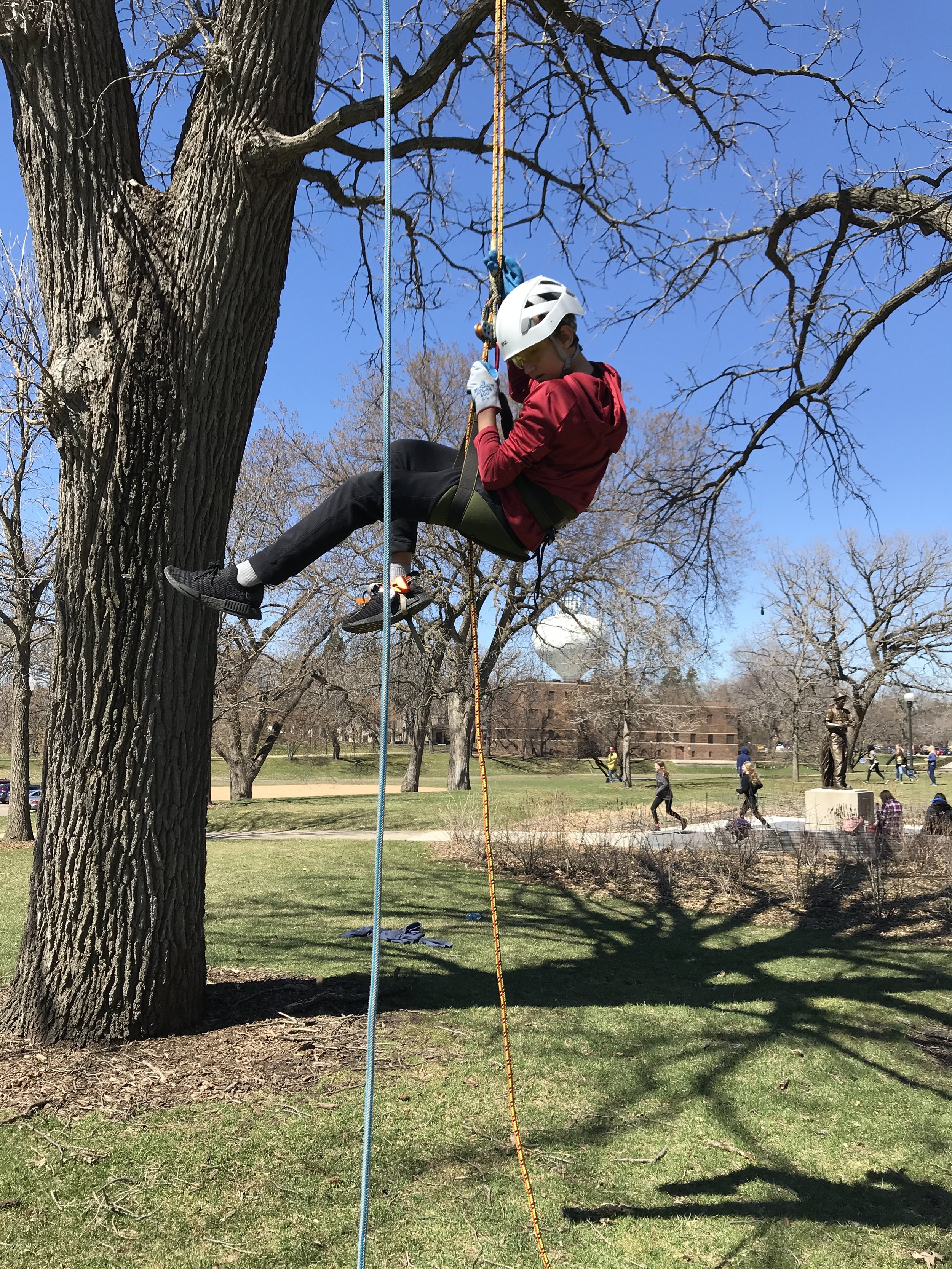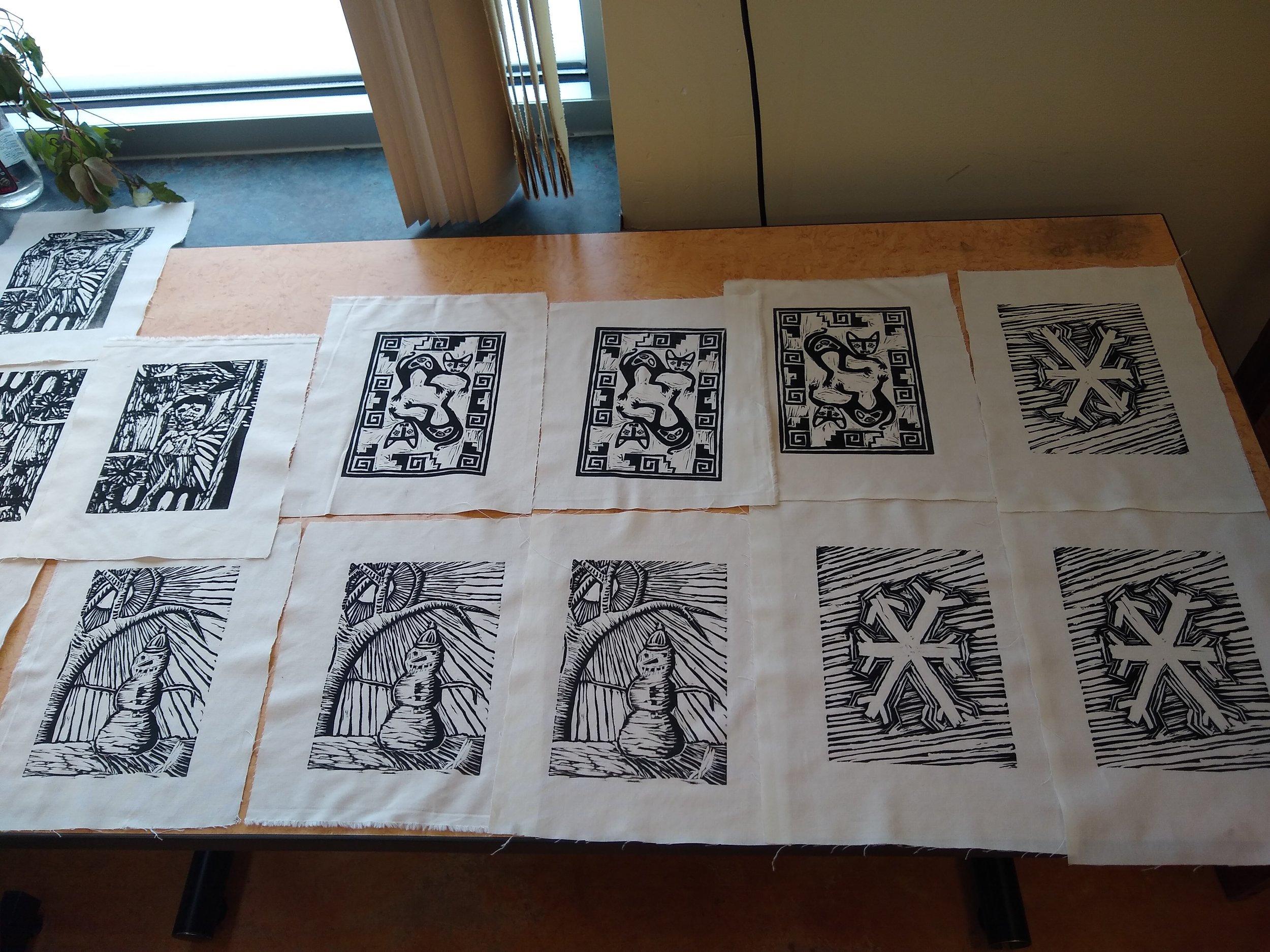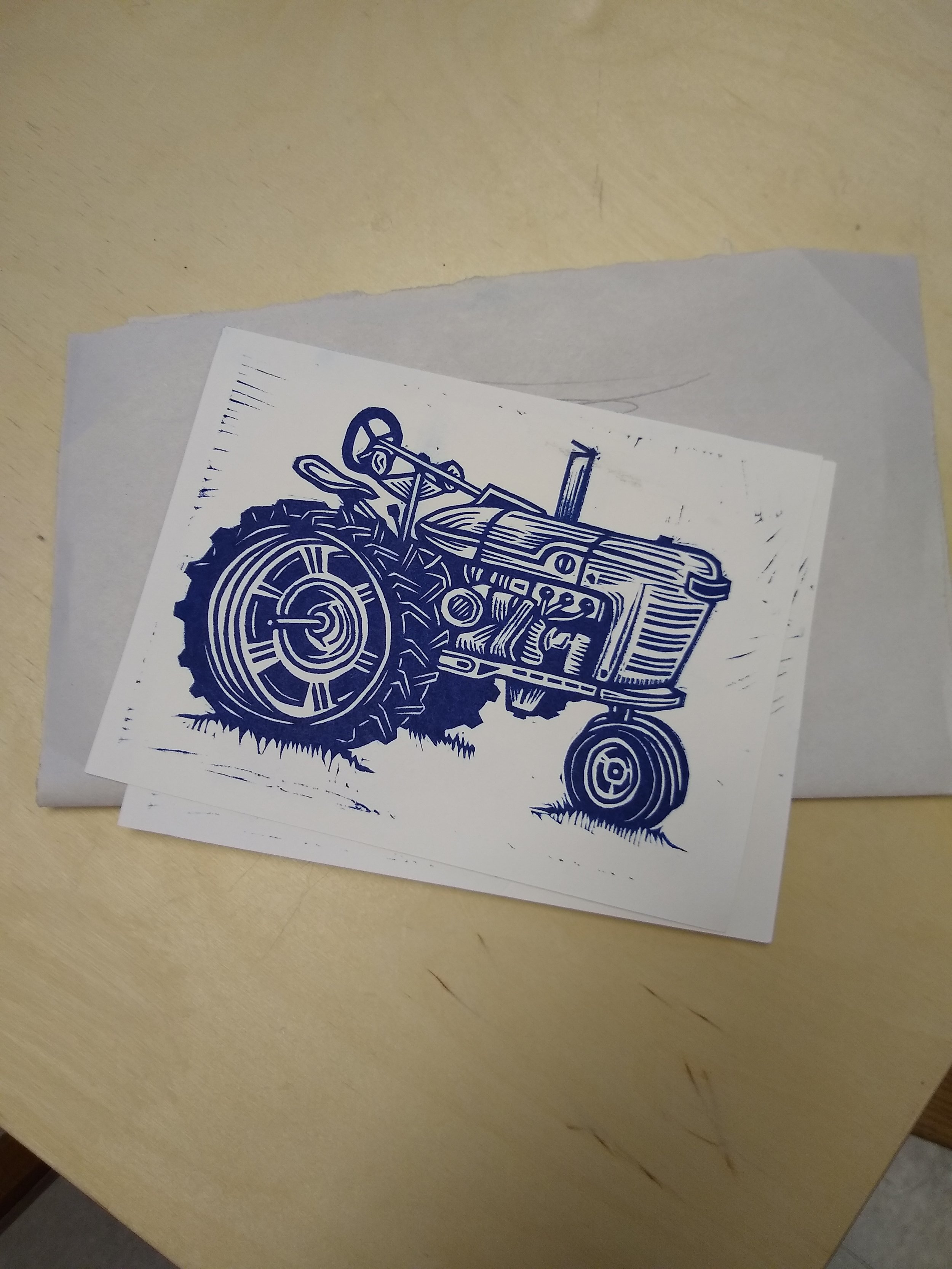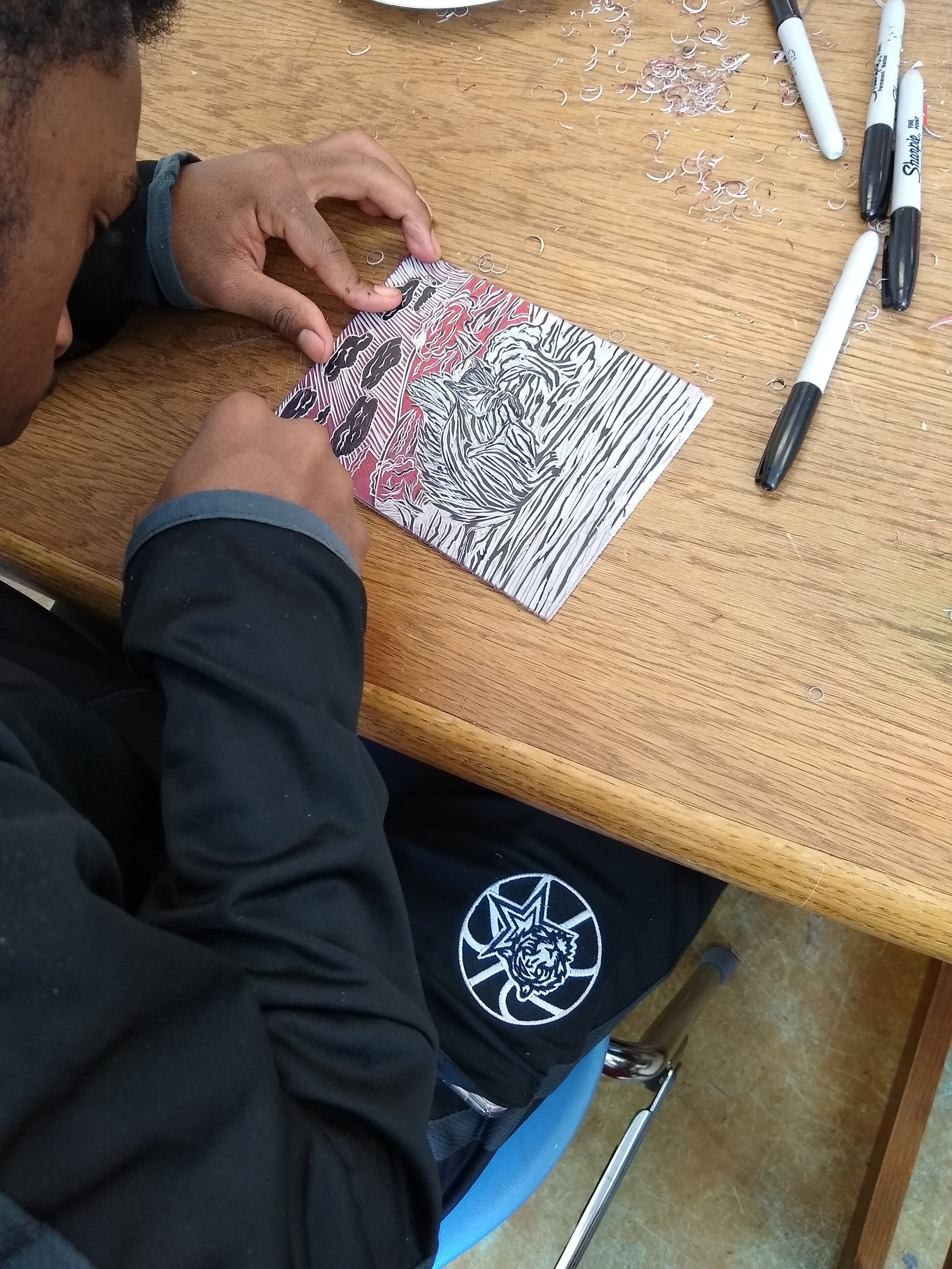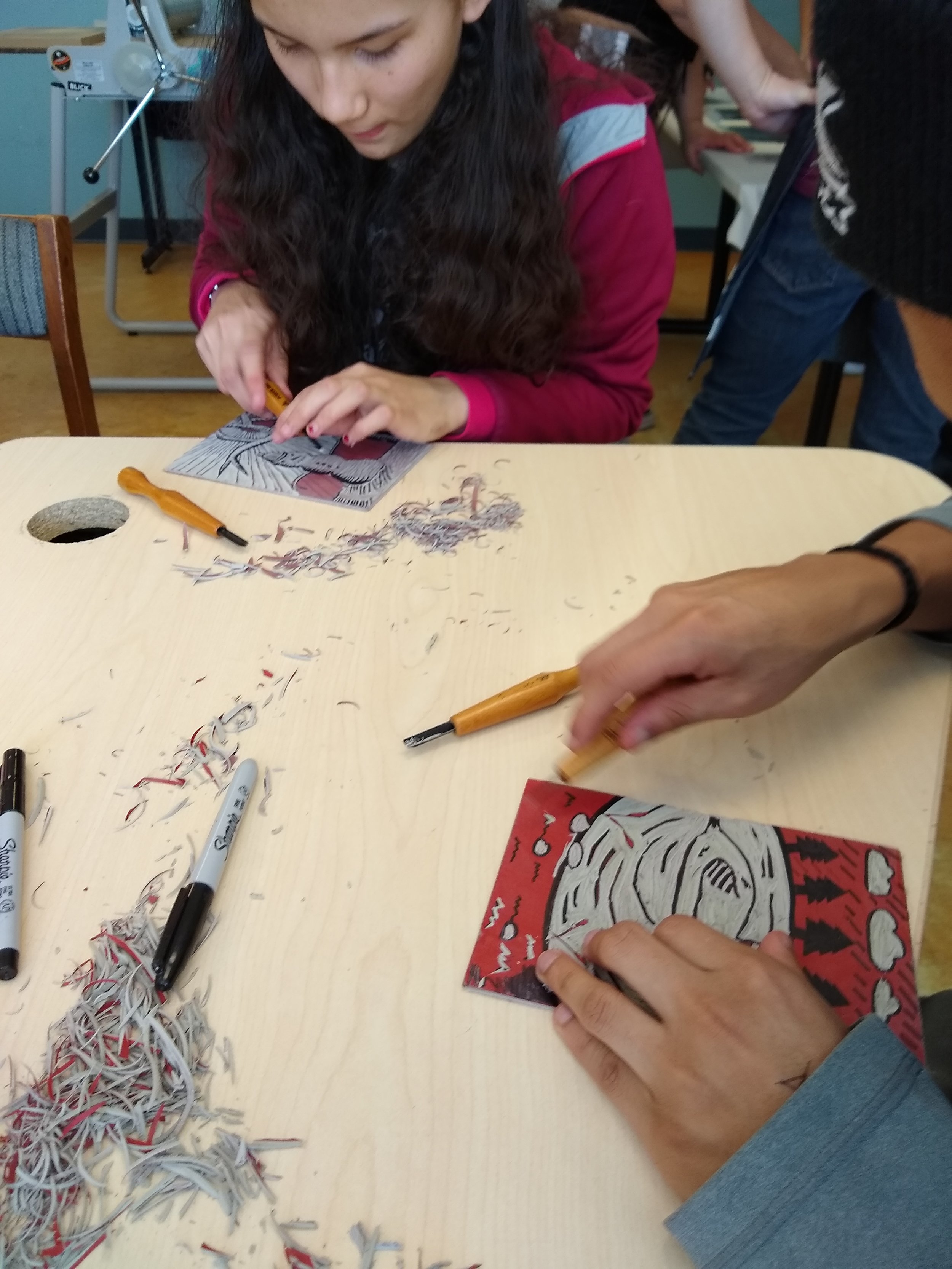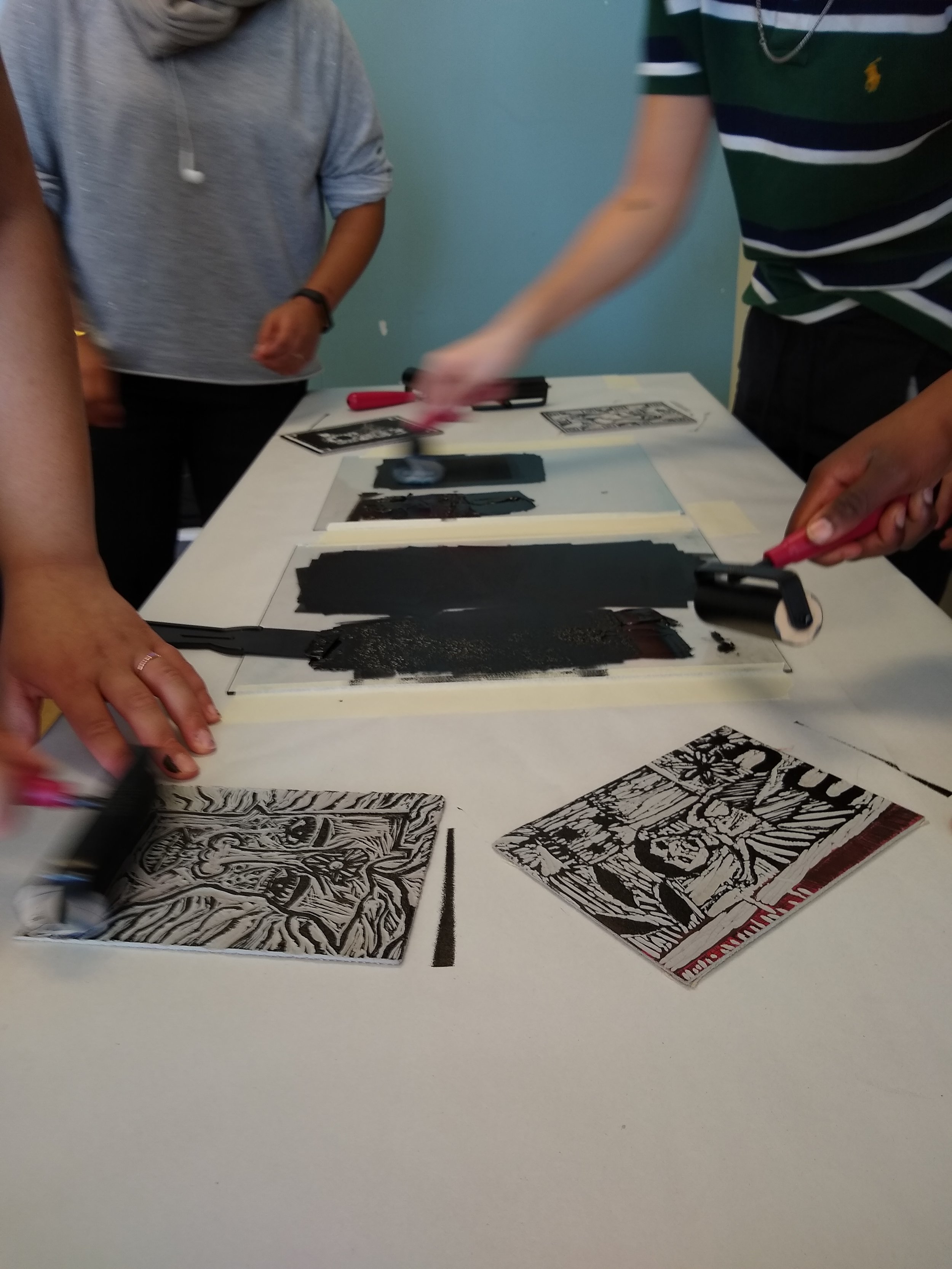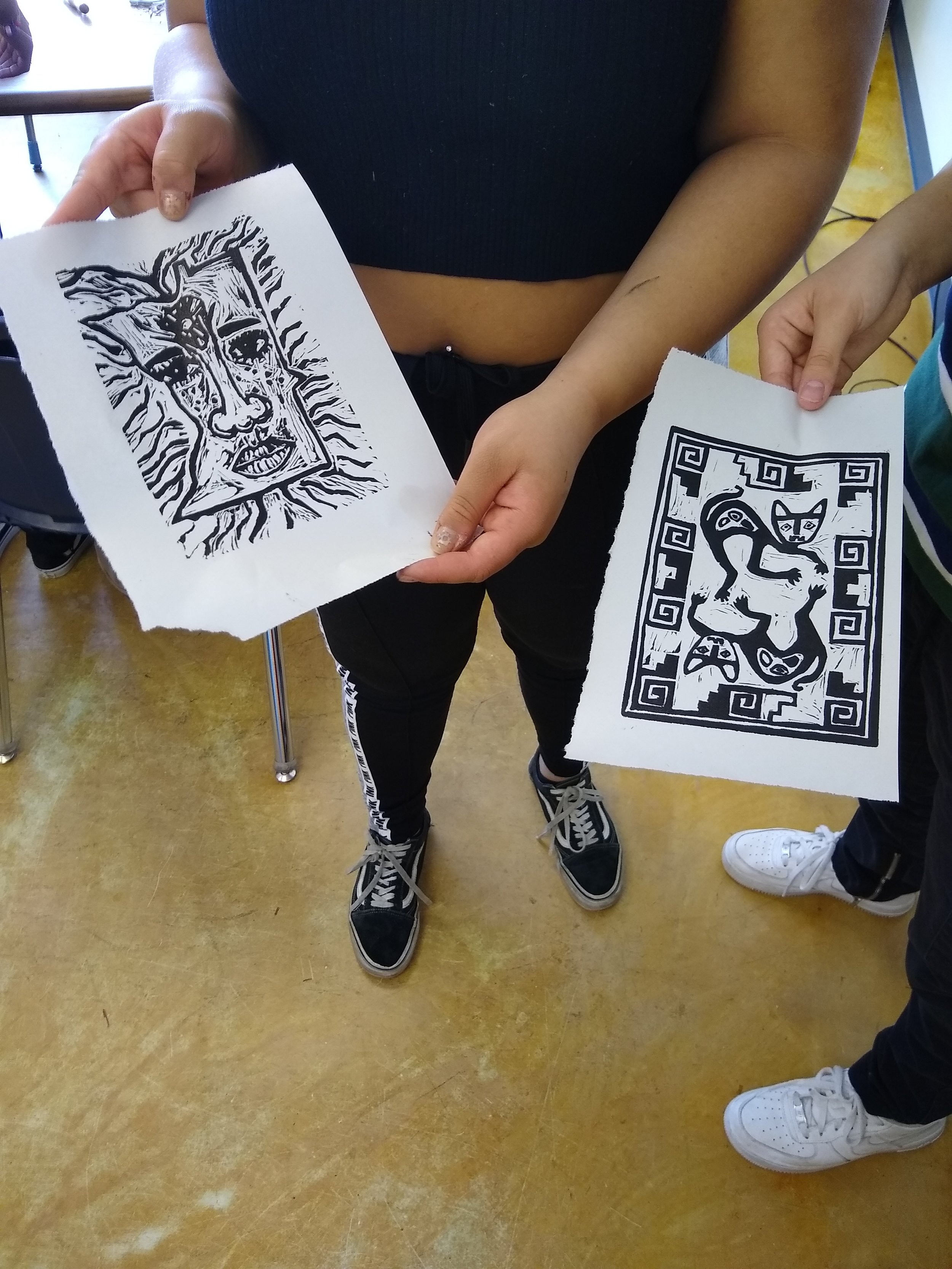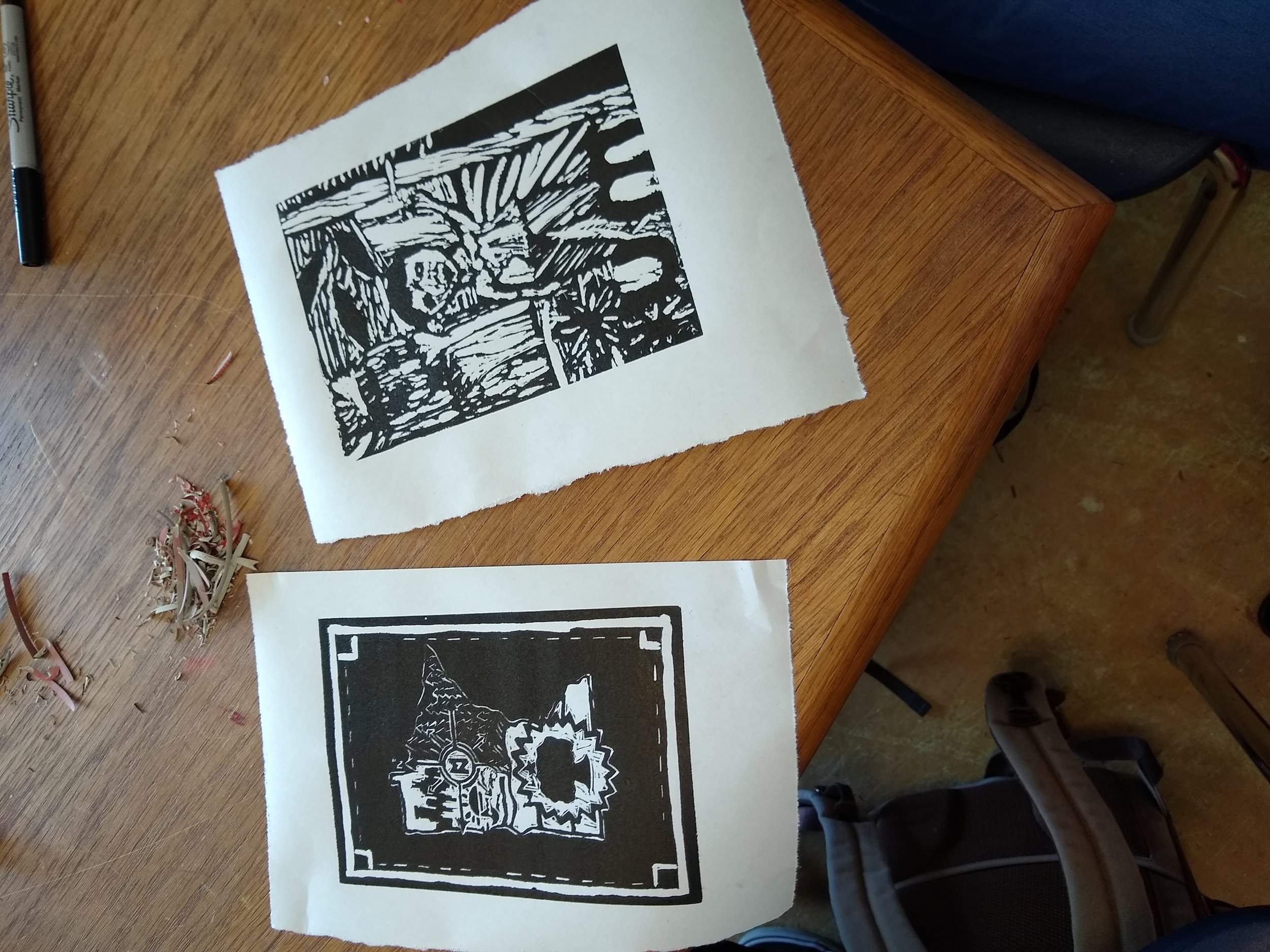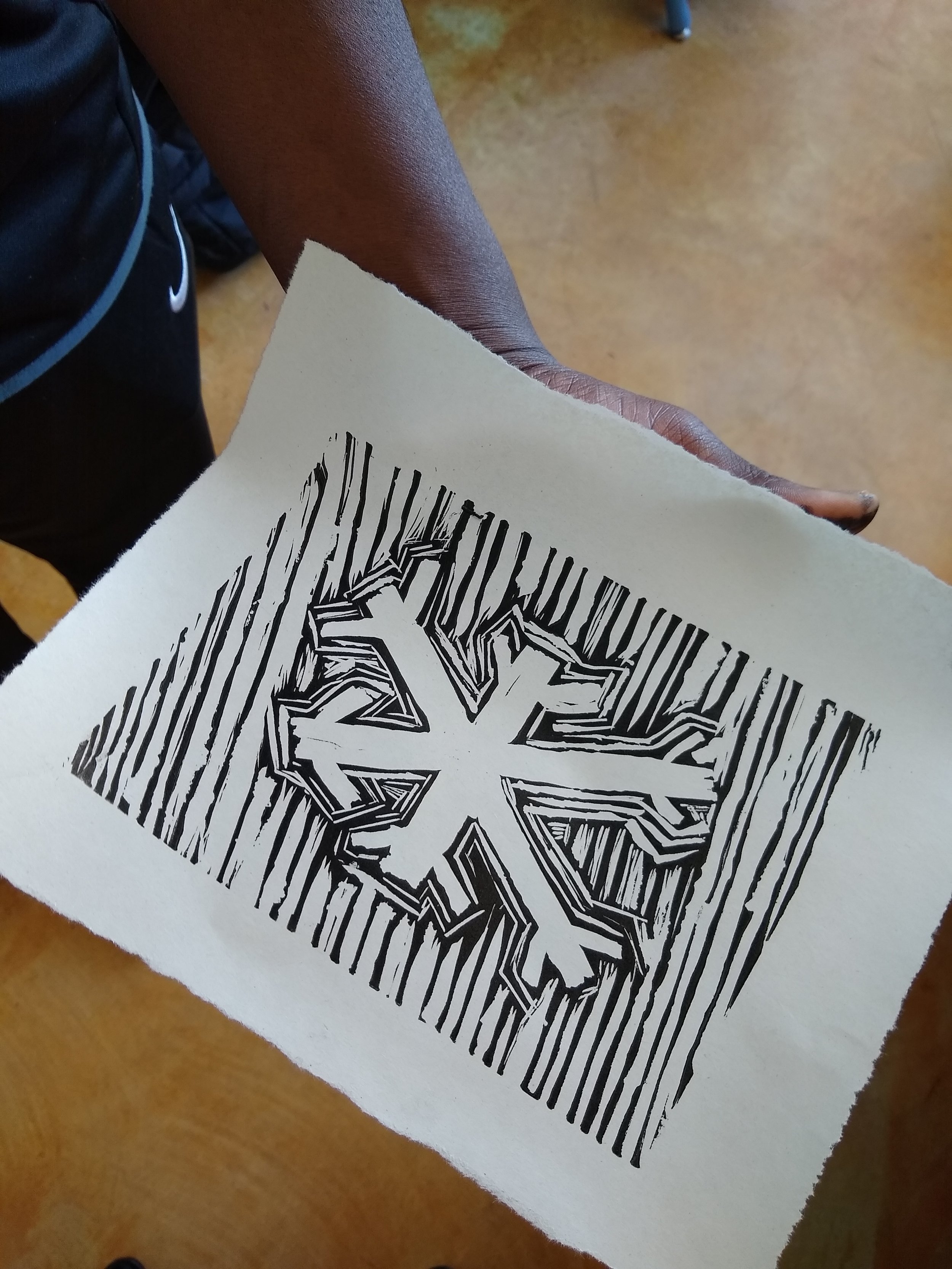Spring Intensives 2019
Ten spring intensives were offered this year, as well as seniors having the option of proposing and organizing their own spring intensives. Below is a summary of some of the key experiences students participated in their last week of school!
Itasca State Park
written by rising 10th grader Lillian Adams
The Itasca group spent three days at Itasca State Park. The trip was through Wilderness Inquiry, and we had five W.I. guides with us. During our day there we canoed during the morning, and after lunch we visited the Mississippi headwaters. We spent a few hours swimming and fishing there. Later, we went to an old fire tower a few minutes away from camp, which was converted into a lookout. The main group stayed at the foot of the tower, while smaller groups went up to the top one at a time. When we were at camp, we spent time chatting, playing games, and relaxing while one of the tent groups worked with some of the guides to prepare dinner.
State Parks
written by State Parks lead guide, Melanie Peterson-Nafziger
At Interstate State Park we explored epic potholes, igneous basalt cliffs, learned about lava flows and hiked along sandstone bluffs that were the bottom of an ancient sea. We enjoyed sweeping vistas of the St. Croix River, hauled buckets of basalt gravel to fill in the eroded trail after the snowy winter, and realized how fortunate we are to live in a state with such beautiful state parks!
Seed Savers
written by Seed Savers guide, Charlie Zieke
Students did incredible work at Seed Savers Exchange in Decorah, Iowa. We spent two full days volunteering, planting cover crops and straw-mulching in 80-degree weather. We camped right on the Iowa River at the beautiful Pulpit Rock Campground and spent a full day exploring Luther College and downtown Decorah in our passenger vans, Bluebell and Black Beauty. There might be some future SSE interns among us!
Hammock-Making: a summary in haiku
Day 1: Wednesday, June 5th
Patience was tested,
Wrestled with sewing machines,
Hammock making rocks.
Day 2: Thursday, June 6th
Finishing hammocks,
We’re all in this together,
Our stuff sacks have holes.
Day 3: Friday, June 7th
Walking to Como,
I’m sweaty in my hammock,
Freeze pops are awesome.
Buttermilk Falls Farm
Garage Band
Upper Elementary Work Share
By: Willa Henkemeyer (Crow Wing, 4th) and Beena Reiter (Crow Wing, 5th)
May 2019- All of the lower and the upper elementary classrooms did a workshare in the second half of May. Different classes did different topics of projects, but the general focus for the upper elementary work share was history.
The purpose of this workshare was to share with the rest of the community history about a lot of things. Such as identity, vikings, herbs and tea, video games, and a lot more! Many of the workshare projects were organized by trifolds. They weren’t all trifolds though, in Blue Earth River there were posters with drawings and sculptures. In Crow Wing River there were trifolds and books. People even made tea and food to share.
The 6th years have a special project that they do each year. Instead of a history project, the 6th graders in Shingobee River and Crow Wing River did an Imaginary Island project. Imaginary Island is a geography project that puts together a lot of the learning that 6th years have done in elementary. They had their projects displayed in Clear Lake River Classroom. They also made clay models of their Islands, which took a lot of concentration and time.
Now we’re going to talk about the workshare in Crow Wing because we’re in that classroom. Our history project was focused on our own Identity and Culture background. There were many genre options for works, such as who I am essay, culture essay and fundamental human needs charts, to just name a few. Everyone enjoyed the final presentation, but the project took 2 months and sometimes was stressful to tackle something so large, but it all paid off. Our class had many visitors and we think that they enjoyed it. There were many different styles of the way people made their books and posters.
6th Year Camping Trip
By: Viv Turbak and Maya Shapiro (Crow Wing 6th years)
The sixth graders of Crow Wing and Shingobee organized a trip to Afton State Park to commemorate the last of the original sixth graders moving to the adolescent level. This trip was held at the end of the year, giving the sixth years two months to plan.
Great River School students overcome real world challenges through travel, practical life skills, arts, and time management in order to enter the adult world with compassion and a sense of responsibility. The sixth grade trip prepares us for skills that we will need in the adolescent community, like the odyssey, the bike trip, and the senior canoe trip.
There were three committees who organized the trip; activities, food, and logistics. We planned all of the meals, we organized group activities and hikes, and we ordered the tents and busses. Planning this trip helped us practice time management, and organizational skills, which are two important skills students at Great River work on developing.
Afton state park is a state park with tent and cabin sites. There are many fun activities that Afton has, like geocaching, archery, hiking, swimming, canoeing, and backpacking. We went on an overnight trip while practicing skills like setting up tents and hiking. This helped prepare us for the bike trip, odyssey, and other adolescent key experiences.
We did a bunch of activities on the trip. One of them was hiking. We hiked to the Saint Croix river and waded into the very flooded, and murky water. We saw a 3-4 ft. long snake by the river, which we think was either a bull snake or a gopher snake. We had so much fun at the river, and even rescued a boat (or a log, but to a bunch of weird sixth graders, what’s the difference?), called the S.S Alistair. The process included lifting a heavy log, sending people to walk out on the log while others held it steady . . . . and lots of shouting at each other.
Other than the hike, our trip consisted mostly of hanging out around the campsite. We did a lot of hammocking. Everyone did things like sleep, talk, read, or eat in the hammocks at one point or another. Another thing that we did was slackline. It was set up, and we all got an orientation. Then, we just went for it! There was a spotter, of course, but also a rope. It was so fun to watch people trying it for the first time.
We played a lot of Ultimate during our campsite freetime. We were all barefoot, and it was so wonderful to have our feet pounding against the ground, trying to block the frisbee. On the second day, Matt brought his three year old daughters, Keegan and Juniper. We played frisbee, and volleyball with them, some students read them books and made them dandelion chain crowns, and also taught them how to hammock and slackline.
On this trip, we learned that camping is a lot of work. Everyone who went on the trip had two meal shifts; cooking, and cleaning. We learned to set up and take down the tents, and took turns filling the water.
Matt, Alaina, and Amanda helped us through so much. They dealt with our stress from planning, they took time out of their days to work with committees, and found work and concentration spaces for us when we needed to meet with our group(s). We would also like to thank Donna for helping us get food to eat, mess kits, stoves, etc. She also ordered the tents for us, and answered all of our emails promptly. All of these guides have been so patient and understanding with all of us, and the things that they have done to support us, are infinite.
Meet Chef Leah Korger
Each month, we’ll highlight a different member of the Nutrition team, starting with the onion-pickling, ranch-making, recipe-creator, Chef Leah Korger (they/them).
What’s your food background?
Growing up mealtime was very important. Every day my parents made sure we all sat down to eat a home cooked meal together. At that time, I had no interest in helping to cook or garden! Thank goodness we all continue to change as we grow! Those meals planted the "food" seed in me. In college I fell in love with anything to do with food (and the science behind it) and loved completing my degree in human biology with an emphasis on nutrition.
Most of what I love about food is it's power to bring people together, physically nourish us, and to build community. After all, everyone has to eat!
What compelled you to do this work?
I'm not done learning yet! I feel with the breadth of career possibilities within our food systems I will never run out of things to master and skills to learn.
What did you do in your previous work?
For the past 4 years I was managing the central kitchen for the Wedge and Linden Hills Coops. Think 200 pound batches of scratch macaroni and cheese! There I developed a new catering menu, organized menu turns for the organization, began a bulk deli salad wholesale program, and a heat and serve hot bar wholesale program. Previously I served as a member of the FoodCorps connecting kids to healthy food through school garden builds, engaging after school programs, and classroom studies. I've also apprenticed at a few organic farms.
What interested you about working at GRS?
I really enjoy building things! The program as a blank canvas was very appealing to me. Setting up procedures, systems, menus, budgets, and figuring out the formula to make the program successful is exciting! More so, the GRS community values and my own values are aligned and that is important to me in my career!
Chef Leah showing their knife skills while prepping three bean chili vegetables
Describe what you've been doing at GRS since you started
Learning how to use the printer (haha)! I've been observing, learning, creating a lot of spreadsheets, setting up vendors, facilitating conversations, roasting chicken, dreaming about future projects, giving high fives, and teaching loads of folks how to use "Geraldine," our food processor.
What is your philosophy around food and cooking?
Food is so many things to me. It is a way to show how much you appreciate, love, or care for others. Food can be a way to heal ourselves, others, and the planet. Healthy food access is a human right, and so is the accessibility of food education. Cooking is also an art and a form of communication - one that is so immersive! You can smell, taste, see, hear, and feel this art form!
Which menu/day are you most excited about and why?
Chicken day is my favorite! I am also excited about our GRS ranch dressing.
Share a favorite recipe and the story behind it:
The last couple years I've been honored to teach and demo at Chef Camp. Chef Camp is an outdoor cooking adventure where (adult) campers can take workshops from chefs and spend the weekend eating until they will pop! Last year I created this unstoppable sauce that I paired with rum barrel smoked chicken, spicy glazed peanuts, and lime zest. It was inspired by the pull of vacation and the feeling of wanting to get out of Dodge for a few days. It also illustrated many points I spoke about including smoke science, the Maillard browning process (my favorite chemical reaction), balancing flavors in a dish, and how to be confident stepping away from recipes and trusting yourself! You'll notice this recipe doesn't have strict amounts listed - play with it! The sweetness of the fruit and richness of the coconut milk is balanced by the acidity in the vinegars, salt, and heat from the spices. This sauce recipe would do well as a tofu marinade, as the base for a vinaigrette, in a cocktail, over grilled chicken, pork, or wherever you could dream!
Ingredients:
1/2 a pineapple (cored and sliced into 1'' thick slices)
1 pint ground cherries (gooseberries, or golden berries)
Anchovy vinegar (to taste)
Rice Vinegar (to taste)
Coconut milk (full fat)
Cayenne or chili flake (to desired heat level)
Turmeric (for color)
Sea salt
Instructions:
Grill pineapple and half of the ground cherries. Puree grilled pineapple, grilled ground cherries, and fresh ground cherries using a blender or food processor. Puree in the remaining ingredients until a smooth texture is achieved. Taste and adjust vinegar and spice levels.
What is your vision for GRS food program?
I see this program growing into whatever this community desires! I'd love to see lots of local and organic foods in lunches, a small catering business for meetings and events, a pizza oven for garden parties, and more crossover between classroom education and the food we're serving! I also think there is a serious opportunity to give students (and the community) a real look at what a career in the food industry is through internships or mentorships. The sky is the limit!
Tell us a fun fact about yourself:
I grew up dancing - ballet, pointe, tap, jazz, swing, Irish, modern, you name it!
Pippa the Stegatortoise
written by Sarah’s Advisory
Her full name is Pippa Oogway Pailem. She loves crispy greens like lettuce and kale and also the occasional carrot. Pippa is an excellent burrower and climber. She is a frequent and welcome participant at Ninth Grade Community Meetings.
School Nutrition May Update
written by Jenny Breen, Nutrition Educator
Chicken Thursday!
Our hot lunch program has been going smoothly as more and more students are enjoying the delicious, beautiful and fresh foods Chef Leah and team are preparing. As the school year winds down, we'll be planning and dreaming up next year’s expanded hot lunch menu. Please let us know what you love about the food, and if your student has not tasted hot lunch yet, please try it! The only way to make this program sustainable-both in terms of continuing to have hot lunches at GRS, and to utilize responsibly and sustainably produced ingredients, is to have community participation!
Chef Leah Korger (left), Sous Chef Mel Coombs (center), and Production Assistant Rita Siraj (right) share a joke while prepping vegetables for Friday’s homemade chili.
Taste Tests
We had a successful last week of taste-testing hot lunches with adolescent students. Students enjoyed the samples and gave the wellness team feedback on flavor, ingredients, and presentation. This feedback is incredibly helpful in gauging what students think about the lunches, and opportunities for improvement. We take this seriously, and incorporate it into our planning and preparation!
Adolescent students in Laura Machacek’s Sculpture elective created hanging food decorations to help beautify our kitchen environment.
School Garden Planning
Many of you know about the beautiful school garden we’ve had at the school for years. What you may not know is that it has been expanded tremendously this year, and there is a giant new garden that will be designed and planted specifically to provide the lunch program with food for school lunches! We are excited to be able to utilize hyper locally grown foods in our school lunches next fall, and will keep people posted about volunteer opportunities throughout the summer for maintaining, harvesting and possibly even preserving garden produce! Watch for summer camps and potentially a family event or two over the summer.
Adolescent students eat outside the cafe on 5/2/19. Once sound abatement issues are resolved, levels will eat together in the gym.
Summer Camps
We have four summer cooking camps planned this summer! Mel, our kitchen Sous Chef, and Jenny, our Nutrition Educator, will be teaching the camps, and are looking forward to some good times in the GRS kitchen! See the summer camp brochure for details, but here are the dates. They will all be morning classes, and will include a freshly prepared lunch (obviously).
"Who Kneads the Dough" June 17-20, (7-12 yrs)
Learn to bake bread and other yummy items made from dough in this fun culinary camp led by GRS chefs.
"Vegetables Every Which Way" July 8-11, (7-12 yrs)
Do you want your camper to eat more veggies? Well, let our professional chef teach them how to create delicious vegetable dishes from farm to table.
"Family Food Traditions" July 22-25, (12-16 yrs)
Explore a variety of foods that are important to so many people’s way of life in this culinary camp. Campers will learn how to cook a variety of dishes from around the world.
"Fabulously Fantastic Foods" August 5-8, (12-16 yrs)
Come and create some new lunch items for the up and coming school year. Your camper will work with our chef in our commercial kitchen to see what it takes to make the menu at Great River School.
Lower Adolescent Interventionist K’rin Jacobsen orders a warm beverage from Cafe Coordinator Donna Goodlaxson. The Heron’s Nest Cafe is open to community members and students alike.
To contact the Nutrition team, please email us at lunch@greatriverschool.org. Happy eating!
Forestry Occupation Practices Tree Ascension
written by Ava Van Brunt
The 7/8 Forestry Occupation went on an outing to Foresters Day at the University of MN on April, 19th 2019. Students started their day with a Pancake Breakfast at the Skok Hall with U of M Forestry students and faculty, then had the option to participate in tree ascension with the TAG (Tree Ascension Group).
A note about tree climbing and forestry. In addition to being fun and contributing to physical fitness, elements of tree climbing include opportunities to develop analytical thinking, improve knowledge and appreciation for natural resources, as well as build self-esteem and a sense of accomplishment. Additionally, tree climbing introduces young people to skills and professional development opportunities in urban forestry and arboriculture.
Ascending a tree is no easy task, but the result is rewarding and the experience is overall pleasant! In order to climb I needed the following, a foot and hand ascender, helmet, sturdy rope, and a harness. Once I clipped myself I to my harness, I pulled my rope down through the ascender and thrusted my hips upward. I repeated this until I reached my stopping point, then I relaxed my grip on the rope, allowing myself to descend. Through this experience, I was able to gain knowledge on something I knew little about. As well as broaden my mindset on what it means to study a tree. I would strongly recommend trying tree ascension to future students in the Forestry Occupation!
National Public Radio GRS Student Podcasts
Great River IB Global Politics students participated in the first-ever National Public Radio student podcast competition. In groups of 2-4 students, juniors and seniors investigated human rights issues in the Twin Cities, compiling their ideas and creative audio resources in the format of 3-12 minute podcasts. Listen to some of their podcasts below!
A podcast exploring what youth can do about homelessness in the Twin Cities
A podcast exploring human trafficking in Minnesota
A podcast exploring censorship and social media
A podcast on English language learners in schools
A podcast on public transit fares and equality
A podcast on the power of the global data network and Internet
IB Testing: Tips & Tricks
written by IB Coordinator, Melanie Peterson-Nafziger
IB exams begin May 7! Students' IB scores are a combination of internal assessments (e.g. presentations, portfolios, labs, interviews, research papers, performances, etc.) that students complete with their teachers during the school year and external assessments (e.g., May IB exams and some other presentations or papers) that are graded entirely by IB examiners from across the world. These are moments for students to showcase their content knowledge and critical thinking skills.
IB students taking exams, what can you do to best prepare yourself for this exciting and sometimes nerve-wracking culminating experience? Read on for tips for the next month.
1. Before Test Day
• Study more—a lot more. It may seem obvious, but insufficient study time is one of the biggest underlying problem for students who suffer from test anxiety. The more times you do something, the easier it will be to do.
• Practice positive thinking. The desire to avoid failure is a very poor motivator. To prime yourself for success, you must learn to banish negative thoughts. Think, “I will do well on this test because I have studied as much as I can and because I know what I need to do to be successful.”
• Sleep well and eat well. Few regular activities have as much of a bearing on stress and anxiety levels than resting your brain and eating well. Take care of yourself always, but pay extra close attention in the days leading up to the test. Exercise too!
2. On Test Day
• Arrive at school a half hour early (or at home) and do some sitting meditation in the garden or elsewhere (optional). Listen to the meditation audio on your phone athttp://www.fragrantheart.com/cms/free-audio-meditations/self-esteem/easing-study-and-exam-stress! Breathe! Practicing some form of meditation or deliberate relaxation helps you to control your breathing, your heart rate and your thought processes. Focus your practice on calming yourself—by dismissing unwanted thoughts, refocusing your mind and controlling your breathing.
• Stand in the power stance in the hall before you enter the room! Hands on hips and feet spread apart, or feet spread apart and arms above head. Sounds silly yet research says it helps you perform better on the exam!
• Don’t study. If you’ve studied well beforehand, you shouldn’t need to study on test day. A nice review would be helpful to jog your memory, but you’re probably not going to learn a lot of new stuff on the day of an exam. You may make yourself anxious, however, by worrying that you’re not ready.
• Prime your brain. Be very thoughtful about what you eat and drink, what medicines you take, etc. For example, if you eat too close to a test, your body may focus more energy on digestion than on thinking. But being hungry won’t help either. Eat something healthy one to two hours before your test. Think about words like "powerful," "competent," "organized," "prepared," "efficient," "ready," "resilient," "strong," and "intelligent" before you enter the room.
• Visualize success. Fill your mind with affirmation. Remind yourself that you have done everything within your power to be ready, and that you will be successful as a result. Picture yourself answering the test questions with ease. Accept that you will do well, and that you have nothing to worry about.
• Engage in a brief expressive writing activity immediately before taking an important test, which research shows significantly improves students’ exam scores, especially for students habitually anxious about test taking. Simply writing about one’s worries before a high-stakes exam can boost test scores. It does it by more than 10%, and it’s quick and free (Ramirez G, Beilock, SL., 2011).
3. During the Test
• Remind yourself that it’s only a game. Remember, tests don’t cause anxiety. The anxiety is your creation, and you can control it. Try regarding your test as a puzzle, there for your amusement only. Sure, you’re trying to score points—but it’s only because winning the game is more fun than losing.
• Begin with a short private affirmation—a kind word to yourself—and a few relaxing breaths. Remind yourself one last time that you have done everything you could to get ready, and now you’ll do all you can to succeed.
• Skim the test during the 5-minute reading time—but only if you think you can. Some people find skimming a test—to jog your memory and identify easier questions—is a helpful strategy. Others find that scanning a test makes them nervous. It’s a good idea, but it’s not for everyone. Decide whether this practice will help you.
• Don’t stay stuck in the mud. Don’t let yourself struggle with a question. Give yourself enough time on it to try to jog your memory, but then move on to the next one. Remind yourself that even as you answer other questions, your brain is still searching for the answer to the one you skipped. Answering other questions while waiting may just help jog that memory.
More at: https://well.wvu.edu/articles/reducing_your_test_anxiety_is_as_easy_as_1_2_3
Little Elk River Does Math!
written by Little Elk River students Azalea Eischen and Lilah Kottke
Yami, Walter and Audra find the square root of 5,929.
In Little Elk River, we currently have three different math groups: Hypatia, Pythagoras, and Lovelace. Next year we will have four. They are all named after mathematicians. We are in Lovelace. Every couple weeks or so we have a set of 10-15 “problems” to complete, for lack of a better word. Right now the problems include measuring the interior angles of different polygons, cubing binomials, finding equivalent fractions, and adding/subtracting fractions with unlike denominators, and division with decimal fractions. We just started learning how to add positive and negative integers. Today we are going to learn about probability by picking colored legos out of a mystery bag. We’re not sure yet what that’s about. Slowly but surely, we are also working on filling in our Math and Geometry dictionaries. John gives us terms in sets of five and we have to try to define them. We will be able to take our dictionaries with us to the adolescent community when we leave Upper Elementary.
Though the Lovelace group meets once or twice a week for presentations, or correcting the problems that we worked on independently, we are expected to do some kind of math every day. Sometimes that means choosing and making our own problems. We can make problems for our each other, too. We think that this math group is good because it help us to do math on a regular basis.
How We Reduce and Reuse in Lower Elementary
written by Rachel Cupps, Minnehaha Creek guide
In Minnehaha Creek, we try to get creative with unwanted materials. We often find used cardboard boxes, leftover tin foil and excess laminate around the school. Rather than letting these items go straight to the recycling bin or worse the landfill we give them a new purpose in our work
Most recently, Minnehaha students created a gallery walk of mammal habitats. Students used everything from cardboard and yarn to laminate sheets and popsicle sticks to create a home for their mammals. Here is how some of our students got creative:
Wiley used laminate to enable the audience to see his clay model but make it so they could not touch it.
Will and Rain construct their habitats out of small pieces so there is enough cardboard to share.
Claire and Lucio use yarn to add texture and vines to their habitats.
Vivian and Victoria add details with paint.
Everyone shares their hard work at the gallery walk. We learned about mammals and their habitats as well as how we can work together to be more sustainable for our planet. Next time you are going to the recycling bin why don’t you think twice and get creative!
ACT & College News
written by Teresa Hichens-Olson, College Accessibility
The ACT will be held at Great River on April 24th. Students should be here and ready to test at 8:30 sharp, having had a good breakfast. They should bring a working calculator with them! Quiet snacks and a water bottle are also encouraged. GRS covers all costs of this ACT test but donations are welcome to continue this free service. All Juniors will be dismissed early on the 24th after the ACT is completed.
GRS will also be offering an ACT study sessions on April 17th from 1-2:30pm in the UA commons. All 11th graders are encouraged to attend. Note that 11th graders will be taking the tests on paper & not electronically so your student should practice with paper tests. These tests are available at your local library & GRS counseling office. Feel free to contact Teresa with any questions that you may have at thichensolson@greatriverschool.org
Poetry Out Loud 2019
Poetry Out Loud encourages students to learn about great poetry through memorization and recitation. This program helps students master public speaking skills, build self-confidence, and learn about literary history and contemporary life. Great River sent two students, Ryland Kranz & Briar Weston, to the regionals competition to recite with other students from around the Metro area. Briar went on to recite at the state competition, reciting with students from all around Minnesota!
iRace 2019 Summit
The eighth annual iRace summit was a successful community effort! iRace students, beginning in October 2018, planned, organized, and put on the all-day conference, bringing in outside community experts, activists, & artists to lead student workshops focused on this year’s theme - Raising Awareness: Intersectionality & Language. Our first ever student keynote speakers, Feneti Mohamed & Isaiah Randle spoke to both the lower & upper adolescent student bodies on their experiences being students of color at the majority white Great River School and how to move forward with grace & solidarity. A big thank you to all the parents and community members who dropped off food for our community potluck!
Pi Day 2019
Pi Day is a Great River tradition - recite ten digits of Pi on 3/14 and get a slice of pie!
This year, ninth grader Briar Weston recited 1,900 digits of Pi from memory, earning themselves a spot as one of the top reciters in the world! The feat took just over twenty minutes and the entire lower adolescent community sat in anticipation & awe of Briar’s memorization skills! To see pictures of everyone who recited Pi in front of the community, click here.
The celebration wasn’t just in the lower adolescent community - upper elementary students got in on the fun too. Classrooms baked pies and did circle exercises, learning more about the wondrous number that is Pi.
Reptiles in St. Croix
written by Liv May Anderson & Syris McBride
It was fun to have snakes in St. Croix classroom. I think that everyone liked touching the snakes. The species of snakes included a cornsnake, milksnake, boa constrictor, hognose snake, and bullsnake. It took five kids to hold the boa constrictor. I hope they come back soon.
Shingobee Spring Update
written by Shingobee guide, Amanda O’Dowd
After a long hard winter, spring is finally here! In Shingobee we have done some spring cleaning and we rearranged our classroom. We have also been studying plants, trees, and herbs. We have had some special guests that have come to talk to us about their work in farming, herbology, and maple sugaring.
Miles Rosenthal's mother, Courtney Tchida, visited our classroom to help us plant spring seeds that will be planted in our school garden and used in our cooking at the end of the school year. Her father, Dale Tchida will be joining our class to discuss how to make maple syrup. Hadley Musselman shared her knowledge of herbs with us, too: she helped us make tinctures and salves. Finally, a group of our students went to the Como Conservatory to observe the plants and visit the rainforest area.
All of our studies around plants have led to further investigation of lavender, chamomile, elderberry, valerian, and many other fun herbs! We are excited to watch the leaves return to the trees, the grass turn green, the flowers to come up and to grow our own food!
CAS Magic
written by Sarah Hansen, CAS Magic coordinator
This month, twenty-four 10th graders are leading CAS experiences for 7/8 graders as a part of the CAS Magic Program Leadership training program. CAS Magic prepares students to lead programming for younger students through an intense training process based on scripted activities aimed at cultivating mentor relationships and group bonding. All 10th graders led a one week session with 7/8 graders last fall and then planned four week sessions based on their own ideas this spring. Some examples of current CAS Magic Programming: Fort-building, Outdoor Games, Sharks and Aquatic Life, Podcasts and Crafts, Music: The CAS, Premier Pro and Acrobat Effects, and Ice Skating.
CAS Magic leaders have enjoyed getting to know the younger students and learning how to support following the norms in group settings. They have also appreciated learning how to design their own program and are more confident to lead their own CAS experiences in Upper Adolescent. 7th and 8th graders report that they have fun playing outside with the older students and they feel a stronger sense of community across the levels. They enjoyed learning new instruments and having a structured activity without adults around.
Tapestry Making - GRS Student of Color Affinity Group
written by Jenny Kordosky, coordinator of race & gender student programming
Hello, hello. Greetings from mid-school year!
As you know, this year Great River School is trying out holding monthly events for the student of color affinity groups. This month, we hosted regional artist Shoua Yang. Shoua is a print-maker with family ties to the Twin Cities. He is a Hmong-American artist who focuses on making keeping Hmong culture accessible and vibrant. Working with Shoua was fantastic - he really enjoys working with students and is so talented and passionate about his craft. He hopes to come back and work with Great River soon! Look for him potentially as a Great Gathering guest or teaching a summer camp!
Shoua worked with 9-12th grade students on a tapestry over two days. Students designed and cut their designs into linoleum on the theme of how they feel their identity is connected to Minnesota. Students left with three prints of their own plus their linoleum cut. Additionally, students make three print on fabric which Shoua will sew into a tapestry for us to display at school.
6-8th grade students had a shorter workshop with Shoua, learning about the history of printmaking, checking out a variety of different kinds of printmaking techniques, and then selecting a design of Shoua’s to print for themselves.
Check out the great images made and mostly designed by students below!
Check out the beautiful design that Shoua made for us celebrating our school with our mascot, the Great Blue Heron!
